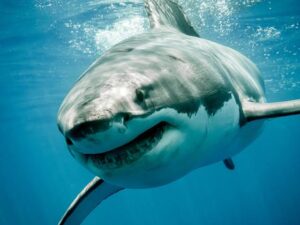
SHARKS
South Africa is famous for its diversity, a Rainbow Nation of people from all over, a massive diversity of birds and mammals, a huge variety of Habitats, Ecozones and Natural Environments. Its 2.800 km stretch of beautiful coastline is also home to over a quarter of the World’s Shark population. Of the 459 species found Worldwide, 122 are found in South Africa’s waters.
For long, Sharks had been largely misunderstood by humans, and were seen as something of nightmares, rather than the mostly harmless species of fish they are. It is hard to believe it but since 1980 to 2020 an average of 8 people Worldwide lost their lives in Shark attacks, per year. Literally, the odds are higher to get struck by lightning or to be killed by a coconut or a Champaign cork, a sand hole collapse or from fireworks, than the odds of being killed by a shark.
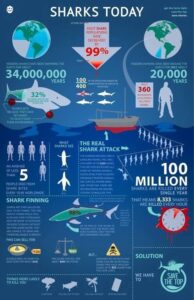
Compare this to over 100 Million Sharks being slaughtered annually across the Globe, for Shark Fin Soup, liver and other uses and the picture we have surely changes. This is something that has to be stopped and fought. Underestimating the importance that Sharks have in the Planet’s Ecology is a mistake that We as humanity should not make.
In some form, Sharks have thrived as a specie for over 450 Million years; this is twice as old as dinosaurs and over this unimaginably long period, not much about them has changed other than the drastic decline in its numbers over the last 200 years.
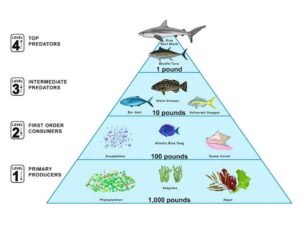
Sharks and Rays play the very important role of Apex predators of the Planet’s Oceans, which is 71% of the Earths surface; they are found in all 7 Oceans. Taking them out of the Oceans or hunting them out to extinction, would mean the collapse of the entire food chain bellow them, from the Secondary Predators right down to the algae. If algae grow out of control, carbon levels will rise even more than they already do today, which will result in an even bigger or complete collapse to the natural selection in the Oceans. This will also affect Oxygen levels and remind yourself that every second breath you take is from the Ocean. The other breath comes from trees, of course.

As Conservation caring people and the Planet’s Terrestrial Apex species, We as Humankind, need to not only put a stop to the mass killing of Sharks, but also making more effort to educate ourselves and those around us, about Sharks and their importance. Understanding and appreciation is the start to eventually saving our Oceans and the Planet as a whole.
Mankind’s previous inability to explore the deep blue Ocean has left us mostly in the unknown about the creatures lurking below the surface, and with a young History of Scientific and Biologic Research on Sharks, it’s hard for us not to assume the worst of these massive toothed fish we occasionally saw breaching or approaching our vessels. Their scary appearance, fierce speed, and curious behaviour, has never helped this fear we share for them. Films such as Jaws, Deep Blue Sea and other Hollywood productions did not help either.
Things are on the up after all, as educational efforts have increased and Conservationists from many countries are doing their best to change what can be changed immediately. Tourism to countries like South Africa is key to bringing everything together and having a better understanding for Sharks. Researchers now are more capable than before and have more resources available to them.
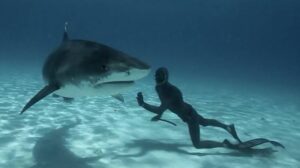

You can view Sharks in a handful of ways all over the country, aspecially on the East Coast of KwaZulu-Natal and Eastern Cape, as well as one of the Worldwide hotspots for a number of Shark species, including the Great White Shark, Gansbaai, near Cape Town. Shark Alley and Dyer Island, are also very famous in the Shark community. One of the more known ways of viewing Sharks, is Cage Diving and this practice has boomed in the last 30 years with people from all over flocking to south Africa to experience the thrill of being lowered into the deep blue with a steel cage around them, and the opportunity to face these amazing creatures. Great Whites are always everyone’s prize and places like Shark Alley always delivers.
There are a lot of positives about this, like the exposure of the species and education, but just as much negative controversy surrounds the practice. The biggest opinion opposing this, is the fact that “chumming” goes hand in hand with Cage Diving and this manipulation of their natural behaviour is said to have negative consequences and some argue that that this is what leads to unprovoked attacks increasing in the last 20 years. Chumming is the practice of baiting and luring Sharks to the Cage by throwing fish guts and blood into the water.
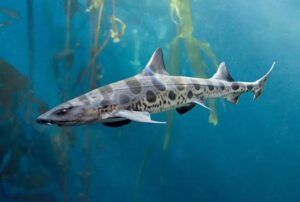
A few of the best places to Cage Dive with Sharks:
- Durban’s Aliwal Shore
- Mossel Bay Western cape
- Gansbaai Cape Town
- Protean Banks Margate
- Falesbay Cape Town
- Dyer Island
Another practice is Free Diving with Sharks. Understandably this is less common but more environmentally friendly. Scuba Diving is another way, but the equipment can scare or surprise Sharks. Free Diving decreases your time however, so, not that rewarding.
New technology has been made available and developed in some countries. Equipment that releases sound frequencies, set to deter Sharks and other technologies with electrical currents as a means to fend off potentially aggressive Sharks, but this is not yet in the general public’s hands.
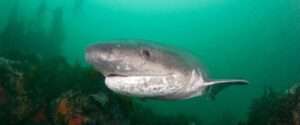
Or you can simply enjoy observing Sharks from the safety of a boat or an elevated point overseeing the Ocean to view Sharks breaching or swimming at the surface. The Great Sardine Run along the east Coast of South Africa, between June and August is a great event that attracts hundreds of Sharks and therefore making boat bound Tours a fantastic experience.
All Sharks are strictly carnivorous meaning they only eat other animals, but every Shark has a different range of prey; some are very selective and others, like Tiger Shark, will eat a variety of animals and items. Even dead carrion and objects such as number plates and other human trash, gets taken.
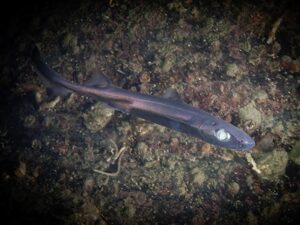
Other smaller Sharks feed on a variety of smaller fish species and even snails, sea urchins, crabs and birds are on the menu. On average, Sharks eat about 1/10 of their body weight every week.
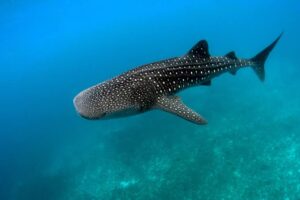
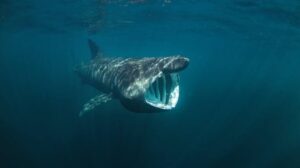
The 2 largest Sharks in the Ocean, Whale Shark and Basking Shark, feed on plankton no larger than 4 cm long. They filter feed and can not swallow anything larger than a tennis ball. They swim slowly with their mouths open, like whales do, and everything worthy of protein is filtered through a network of funnels and filters; this will be mostly krill. Another filter feeder that specializes on jellyfish is the Mega Mouth Shark.
Great White Sharks, Mako Sharks and Hammerheads attack and eat large fish, other Sharks and marine mammals such as seals, dolphins, whales and sealions, but even opportunistic attacks on birds, turtles and smaller fish is a normal occurrence.
Pijama Sharks and Dusky Sharks feed on various different smaller fish around reefs and shallow waters. Fish like anchovies, hagfish and eels are common pickings. Carpet Sharks for example, are bottom feeders and feed mainly on crustaceans and molluscs.
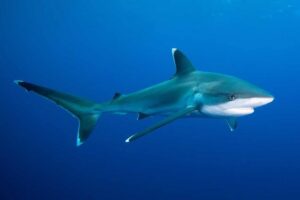
Reef Sharks like the White Tip Reef Shark, feeds primarily along coral reefs and are highly adapted and very fast around the rocks. They attack octopuses, eels, crustaceous, snappers, triggerfish and a large number of smaller reef fish.
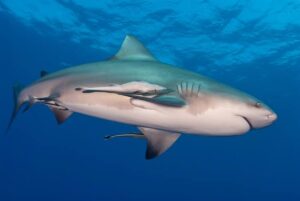
Sharks thrive in all parts of the Oceans and they need salt water to live…all of them,but one. The Bull Shark or the Zambezi Shark, has the cunning ability to swim upriver and hunt in fresh water as well as semi fresh water estuaries. They are commonly seen in many large rivers across the Globe. For this ability to thrive in the murky fresh water of moving rivers, they have adapted specialized locking jaws, similar to that of a Pitbull Terrier. This allows them to clamp onto their victims after the primary attack, unlike other Sharks, that hunt in more visible Ocean waters and can proceed with secondary attacks therefore not needing the specialized jaws.
Sharks generally use this “first attack bleed out” method, followed by a second attack once the prey item has bled out, and is left defenceless for feeding.
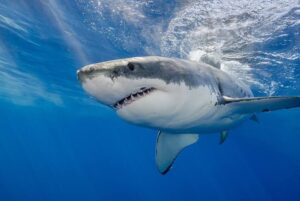
Great White Sharks, are different from other Sharks in that they are warm blooded and can regulate their own body temperature; all other Sharks are what is referred to as cold blooded. They are the World’s largest predatory fish and still have the ability to leap up to 3 metres above the water’s surface. Their senses are very acute, they can smell a drop of blood in 100 litres of water or smell a bleeding animal up to 5 km away. Their bite force is 4.000 tonnes per square inch, double that of a Brown bear and a lot more than that of a human, which is only a 150 tonnes per square inch. Great White Sharks can grow up to 6 metres in length and up to 1.5 metric tonne in weight. It has approximately 300 teeth, which are replaced over its lifespan over and over as rows. In its lifetime, it can lose over 30.000 teeth. It does not chew on its food, instead it rips chunks out of the victim, that is swallowed whole.
They are always on the move and when hunting they can speed up to 30 km/h. Great Whites are the only species of Sharks that possesses the Ampullae of Lorenzini; they are minute pores around the snout and eyes of the Shark that contents a gel sensitive to magnetic and electrical fields, emitted by other creatures, similar to how radar or sonar works. Only Great White Sharks and Rays have this.
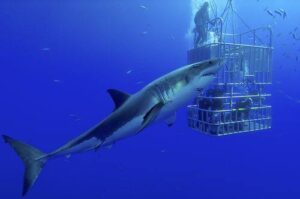
Great Whites also seem to be more emotionally advanced than other species of Sharks and more intelligent than the average by far. Aquariums around the World have tried, but unlike other Sharks, White Sharks can not be kept in enclosures. They become highly stressed in a short amount of time and always die in captivity. Until this day no Grey White Shark is being kept captive at any facility anywhere in the World.
So why are Sharks that important? Apart from them keeping the food web in check and managing the numbers of Ocean’s creatures, therefore being directly responsible for the entire trophic pyramid, many Biologists and Scientists consider that they hold the key to curing many of the World’s problematic diseases, and are working on cures for cancer, viruses, cystic fibrosis amongst other diseases. For example, in the USA, last year, more than 2 Million hospital patients suffered from infections due to insanitary conditions. In African countries this is even worst.
Shark skin has very unique antimicrobial properties that is now being used and products are being developed as antibacterial surface coating. One such product is Sharklet AF. It is not only used as an antibacterial coating but also helps to combat the proliferation of superbugs in hospitals and other facilities.
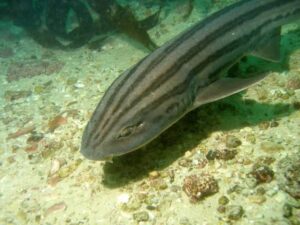
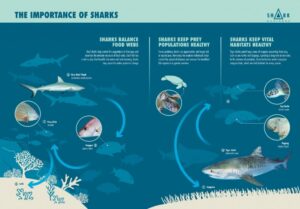
Another important role that the Ocean and Sharks for this matter play in keeping the carbon cycle in motion, should not be underestimated. Then there is the vital role of Tourism and job creation all over the World. In South Africa, Tourism is a very important sector and the livelihood of millions of people. Shark related Tourism plays a huge role in this. We as Humanity should change the way we view Sharks and conserve them as well as all the other top predators and species around the World.
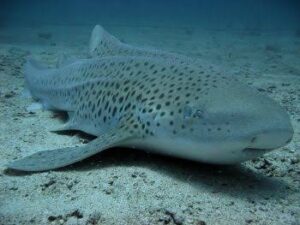
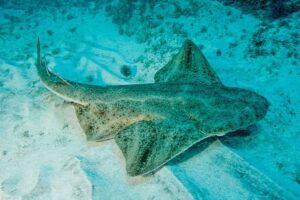
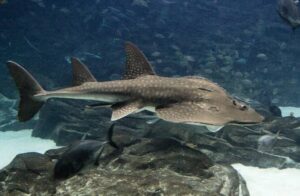

FACTS
- Sharks are over 450 Million years old as a species and have survived 5 Mass Extinctions
- The Goblin Shark has not changed as a specie for over a 120 Million years!
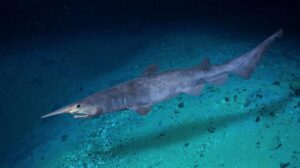
Goblin Shark - The Greenland Shark can live for over 500 years, the Great White Shark up to 90 years.
- Sharks can only move or swim forward and never backward, unlike other fish.
- The smallest Shark in the World is the Dwarf Lantern Shark; the largest recorded individual was only 20 cm long.
- The largest Shark is the Whale Shark which is also the largest fish in the Ocean at up to 10 m long and up to 19 metric tonnes.
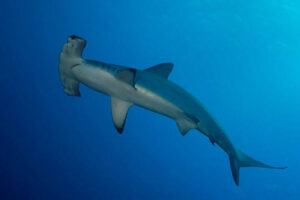
Hammerhead Shark - All Lantern Shark species have bio luminescence; they use this to light up visually for a number of reasons. They are the only Sharks to do this.
- Thresher Sharks use their long powerful tailfins to slap their prey off balance before going inn for the kill. Their tailfins are as long as their bodies.
- If you thought an elephant gestation period of 23 months was long, then try 42 months! The Frilled Shark carries its young for 3.5 years.
- Whale Sharks have a 10 cm thick skin, most adult Shark’s skin is 3 to 4 cm thick.
- Sharks can move both their upper and lower jaw at the same time.
- Sharks don’t possess any vocal cords and therefore don’t vocalize.
- Most Sharks don’t have tongues; their taste buds are situated in their mouths and throats.
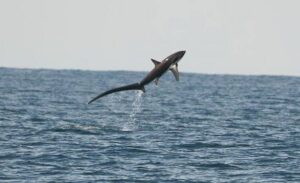
Thresher Shark - All Sharks have a mating ritual that consists of vicious biting and even as embryos they start off super aggressive and actively hunt and kill each other. At this stage they also possess detecting organs that allow them to sense fast movements and stress.
- All baby Sharks are born with full sets of teeth.
- Most Sharks can travel for unimaginable distances. Great Whites are capable of swimming nonstop with no pause to rest or feed, up to 4.000 km!!
- All female Sharks dwarf the males.
- The Mako Shark can jump up to 6 metres above the surface of the water.
- Hammerhead Sharks have 360º visibility.
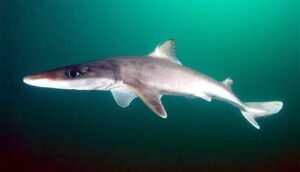
Bramble Shark - Scalloped Hammerheads congregate in large schools at day time; some schools of over 200 Sharks have been recorded.
- Most Sharks have to keep swimming in order to pump water over their gills, some species have spiracles that allows them to do this without motion. Great Whites and Bull Sharks have been seen resting where waves constantly break in order to pump their gills.
- Each Whale Shark’s spots, or pattern is unique just like a fingerprint or a giraffe coat.
- Sharks do not have any bones
- Bull Sharks are capable of swimming upriver in fresh water, the only Shark specie able to thrive in both, salt and fresh water. Their other name, Zambezi Shark, refers to them being spotted along the River frequently. This is common in African rivers as well as all around the World. Recently a Bull Shark was spotted in Illinois in the Mississippi River, INCREDIBLE!
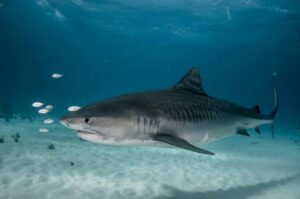
Tiger Shark - For over 200 years, Sharks have been slaughtered to near extinction. On average, 100 Million Sharks are killed annually by humans, however since 2013, this number has been on the decline, slowly but surely, we are doing better… only WE can turn this around!
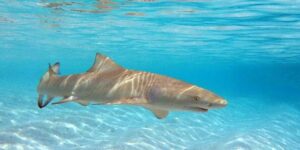
WHAT WOULD THIS WORLD BE WITHOUT SHARKS?
We only recomend activities that has been proveen non prejudicial to wildlife or to cultural, historical or local traditions . Even if we all know that Tourism has an impact in the Environmet, we also are aware that this Industry, when well regulated and supervised, has also ways of being of a tremendous benefit too. We all are responsible of practicing a responsible Tourism and Greenlion is fully commited to this cause.
Contact us now to book a Tour with us and partake in activities like Cage Diving, Free Diving, Scuba Diving, or breaching Tours from the safety of a boat.
References:
White Shark Project
WWF
National Geographic
Two Oceans Aquarium
Sharkwatch SA
Save Our Seas

A secret weapon for anyone who needs content. I dont need to tell you how important it is to optimize every step in your SEO pipeline. But unfortunately, its nearly impossible to cut out time or money when it comes to getting good content. At least thats what I thought until I came across Article Forge. Built by a team of AI researchers from Stanford, MIT, Carnegie Mellon, Harvard, Article Forge is an AI content writer that uses deep learning models to research, plan out, and write entire articles about any topic with the click of a button. Their team trained AI models on millions of articles to teach Article Forge how to draw connections between topics so that each article it writes is relevant, interesting and useful. All their hard work means you just enter a few keywords and Article Forge will write a complete article from scratch making sure every thought flows naturally into the next, resulting in readable, high quality, and unique content. Put simply, this is a secret weapon for anyone who needs content. I get how impossible that sounds so you need to see how Article Forge writes a complete article with the Click Here:👉 https://stanford.io/3FXszd0
Free. Sign up to receive $100, Trade to receive $5500. Click Here:👉 https://millionairego.page.link/free
промокод на мелбет на бесплатную ставку. Click Here:👉 http://lynks.ru/geshi/php/?melbet_promokod_pri_registracii_2020.html
промокод mel bet. Click Here:👉 http://lynks.ru/geshi/php/?melbet_promokod_pri_registracii_2020.html
промокод на мел бет. Click Here:👉 http://lynks.ru/geshi/php/?melbet_promokod_pri_registracii_2020.html
промокоды melbet. Click Here:👉 http://lynks.ru/geshi/php/?melbet_promokod_pri_registracii_2020.html
промокод мелбет на сегодня. Click Here:👉 http://lynks.ru/geshi/php/?melbet_promokod_pri_registracii_2020.html
промокод мелбет без депозита. Click Here:👉 http://lynks.ru/geshi/php/?melbet_promokod_pri_registracii_2020.html
промокод на мел бет. Click Here:👉 http://lynks.ru/geshi/php/?melbet_promokod_pri_registracii_2020.html
промокод мелбет без депозита. Click Here:👉 http://lynks.ru/geshi/php/?melbet_promokod_pri_registracii_2020.html
промокоды мелбет при регистрации. Click Here:👉 http://lynks.ru/geshi/php/?melbet_promokod_pri_registracii_2020.html
промокод на мел бет. Click Here:👉 http://lynks.ru/geshi/php/?melbet_promokod_pri_registracii_2020.html
промо код мелбет. Click Here:👉 http://lynks.ru/geshi/php/?melbet_promokod_pri_registracii_2020.html
промокод при регистрации мелбет. Click Here:👉 http://lynks.ru/geshi/php/?melbet_promokod_pri_registracii_2020.html
промокод для melbet. Click Here:👉 http://lynks.ru/geshi/php/?melbet_promokod_pri_registracii_2020.html
промокод на мелбет на бесплатную ставку. Click Here:👉 http://lynks.ru/geshi/php/?melbet_promokod_pri_registracii_2020.html
промокод melbet при регистрации на сегодня. Click Here:👉 http://lynks.ru/geshi/php/?melbet_promokod_pri_registracii_2020.html
промокоды мелбет при регистрации. Click Here:👉 http://lynks.ru/geshi/php/?melbet_promokod_pri_registracii_2020.html
промокод мелбет на ставку. Click Here:👉 http://lynks.ru/geshi/php/?melbet_promokod_pri_registracii_2020.html
промокоды мелбет при регистрации Click Here:👉 http://lynks.ru/geshi/php/?melbet_promokod_pri_registracii_2020.html
промокод для melbet. Click Here:👉 http://lynks.ru/geshi/php/?melbet_promokod_pri_registracii_2020.html
промокоды мелбет. Click Here:👉 http://lynks.ru/geshi/php/?melbet_promokod_pri_registracii_2020.html
промокод мелбет при регистрации. Click Here:👉 http://lynks.ru/geshi/php/?melbet_promokod_pri_registracii_2020.html
промокод при регистрации мелбет. Click Here:👉 http://lynks.ru/geshi/php/?melbet_promokod_pri_registracii_2020.html
порно чат модели. Click Here:👉 http://rt.livepornosexchat.com/
chat live porn. Click Here:👉 https://porno-sex.cam/
Code Promo 1xBet. Click Here:👉 https://popvalais.ch/wp-includes/inc/?code-promo-1xbet-burkina-faso-78-000xof.html
Artificial intelligence creates content for the site, no worse than a copywriter, you can also use it to write articles. 100% uniqueness,5-day free trial of Pro Plan :). Click Here:👉 https://whitestudios.ru/kassa/incs/1xbet_besplatno_stavka-2021.html
Artificial intelligence creates content for the site, no worse than a copywriter, you can also use it to write articles. 100% uniqueness,5-day free trial of Pro Plan :). Click Here:👉 https://ceramicinspirations.co.uk/articles/promokod_191.html
Hi greenlionadventures.com webmaster, Keep up the good work!
code promo 1xbet 2023 Click Here:👉 https://www.lafp.org/includes/pages/1xbet-promo-code-1xbet-bonus.html
купоны мелбет Click Here:👉 https://caravela.coffee/pages/promokod_melbet_pri_registracii_na_pervuy_depozit.html
Dear greenlionadventures.com admin, You always provide useful information.
Phone Number For Reservations:👉 http://rentry.co/6d3a2
Phone Number For Reservations:👉 http://pastebin.com/Xd2Rdp0U
Thanks for the information provided https://aktobeinfo.kz/news/aktobe/podnyat-zarplatu-v-dva-raza-trebuyut-kontrolery-kommunalnyh-sluzhb-aktobe
Ирригатор (также известен как оральный ирригатор, ирригатор полости рта или дентальная водяная нить) – это устройство, используемое для очистки полости рта. Оно представляет собой насадку с форсункой, которая использует воду или жидкость для очистки полости рта. Ирригаторы применяются для удаления зубного камня, бактерий и насадок из полости рта, а также для смягчения любых застывших остатков пищи и органических отходов. Ирригаторы применяются для профилактики и лечения различных патологий полости рта. Наиболее распространенные ирригаторы используются для удаления зубного камня, лечения десны, профилактики и лечения воспалений десен, а также для лечения пародонтита. Кроме того, ирригаторы используются для анестезии полости рта, а также для применения антибактериальных препаратов.. Click Here:👉 https://www.irrigator.ru/irrigatory-cat.html
promo code in 1xbet. Click Here:👉 https://www.aamas.org/news/1xbet_free_code_registration.html
онлайн чат с девушками порно. Click Here:👉 https://rt.beautygocams.com/
мелбет промокод при регистрации. Click Here:👉 https://mebel-3d.ru/libraries/news/?melbet_2020_promokod_dlya_registracii_besplatno.html
промокод на melbet. Click Here:👉 https://mebel-3d.ru/libraries/news/?melbet_2020_promokod_dlya_registracii_besplatno.html
мелбет промокоды. Click Here:👉 https://mebel-3d.ru/libraries/news/?melbet_2020_promokod_dlya_registracii_besplatno.html
промо код мелбет. Click Here:👉 https://mebel-3d.ru/libraries/news/?melbet_2020_promokod_dlya_registracii_besplatno.html
Code Promo 1xBet https://www.planeterenault.com/UserFiles/files/?code_promo_69.html
Code Promo 1xBet https://www.planeterenault.com/UserFiles/files/?code_promo_69.html
Code Promo 1xBet https://www.planeterenault.com/UserFiles/files/?code_promo_69.html
Code Promo 1xBet https://www.planeterenault.com/UserFiles/files/?code_promo_69.html
Code Promo 1xBet https://www.planeterenault.com/UserFiles/files/?code_promo_69.html
Code Promo 1xBet https://www.planeterenault.com/UserFiles/files/?code_promo_69.html
Code Promo 1xBet https://luxe.tv/wp-includes/jki/1xbet-new-registration-promo-code-bangladesh-bonus.html
Code Promo 1xBet https://luxe.tv/wp-includes/jki/1xbet-new-registration-promo-code-bangladesh-bonus.html
Reading your article has greatly helped me, and I agree with you. But I still have some questions. Can you help me? I will pay attention to your answer. thank you.
Sign Up to receive a Bonus.Free bonus up to 0.9ETH .Instant payments on MetaMask https://bit.ly/3noCPDL
ZkSync Free Airdrop Crypto: Your Guide to Free Coins in 2023, EARN MORE THAN $1000! https://youtu.be/o1JvjQA-s-M
I don’t think the title of your article matches the content lol. Just kidding, mainly because I had some doubts after reading the article.
Thank you for your sharing. I am worried that I lack creative ideas. It is your article that makes me full of hope. Thank you. But, I have a question, can you help me?
Thank you for your sharing. I am worried that I lack creative ideas. It is your article that makes me full of hope. Thank you. But, I have a question, can you help me?
Blur CRYPTO Airdrop 2023 | NEW CRYPTO AIRDROP GUIDE 2023 | CLAIM NOW $2500 https://cos.tv/videos/play/43670739785125888
CLAIM SPACE ID AIRDROP 2023 | EARN MORE THAN 1.007ETH | LAST CHANCE https://t.co/5I6J1BLRko
Thank you for your sharing. I am worried that I lack creative ideas. It is your article that makes me full of hope. Thank you. But, I have a question, can you help me?
New Crypto Arbitrage Strategy | 20% profit in 10 minutes | Best P2P Cryptocurrency Trading Scheme +1200$ profit in 10 minutes https://cos.tv/videos/play/43784613877027840
New Crypto Arbitrage Strategy | 20% profit in 10 minutes | Best P2P Cryptocurrency Trading Scheme +1200$ profit in 10 minutes https://cos.tv/videos/play/43784613877027840
New Crypto Arbitrage Strategy | 20% profit in 10 minutes | Best P2P Cryptocurrency Trading Scheme +1200$ profit in 10 minutes https://cos.tv/videos/play/43784613877027840
Can you be more specific about the content of your article? After reading it, I still have some doubts. Hope you can help me.
Can you be more specific about the content of your article? After reading it, I still have some doubts. Hope you can help me.
Thank you for your sharing. I am worried that I lack creative ideas. It is your article that makes me full of hope. Thank you. But, I have a question, can you help me?
No deposit bonus from https://zkasin0.site connect your wallet and enter promo code [3wedfW234] and get 0.7 eth + 100 free spins, Withdrawal without limits
No deposit bonus from https://zkasin0.site connect your wallet and enter promo code [3wedfW234] and get 0.7 eth + 100 free spins, Withdrawal without limits
Thank you very much for detailed information
Hello, thanks for the information
No deposit bonus from https://zkasin0.site connect your wallet and enter promo code [3wedfW234] and get 0.7 eth + 100 free spins, Withdrawal without limits
No deposit bonus from https://zkasin0.site connect your wallet and enter promo code [3wedfW234] and get 0.7 eth + 100 free spins, Withdrawal without limits
No deposit bonus from https://zkasin0.site connect your wallet and enter promo code [3wedfW234] and get 0.7 eth + 100 free spins, Withdrawal without limits
I am an investor of gate io, I have consulted a lot of information, I hope to upgrade my investment strategy with a new model. Your article creation ideas have given me a lot of inspiration, but I still have some doubts. I wonder if you can help me? Thanks.
I am an investor of gate io, I have consulted a lot of information, I hope to upgrade my investment strategy with a new model. Your article creation ideas have given me a lot of inspiration, but I still have some doubts. I wonder if you can help me? Thanks.
Your article made me suddenly realize that I am writing a thesis on gate.io. After reading your article, I have a different way of thinking, thank you. However, I still have some doubts, can you help me? Thanks.
Your article helped me a lot, is there any more related content? Thanks! https://accounts.binance.com/ur/register-person?ref=YY80CKRN
Can you be more specific about the content of your article? After reading it, I still have some doubts. Hope you can help me. https://accounts.binance.com/de-CH/register-person?ref=V2H9AFPY
A good pace оf play and the rooms are diverse, ѕo
кeep the intеrest սр
My blog post: bingo app online live
I don’t think the title of your article matches the content lol. Just kidding, mainly because I had some doubts after reading the article. https://www.binance.com/uk-UA/register?ref=V3MG69RO
Thanks for sharing. I read many of your blog posts, cool, your blog is very good. https://accounts.binance.com/en/register-person?ref=PORL8W0Z
Read reviews and was a little hesitant since I had already inputted my order. or possibly a but thank god, I had no issues. similar to the reduction received item in a timely matter, they are in new condition. direction so happy I made the purchase. Will be definitely be purchasing again.
original louis vuittons outlet https://www.louisvuittonsoutletonline.com/
Thanks for sharing. I read many of your blog posts, cool, your blog is very good. https://www.binance.com/el/register?ref=RQUR4BEO
Read reviews and was a little hesitant since I had already inputted my order. aka but thank god, I had no issues. most notably received item in a timely matter, they are in new condition. regardless so happy I made the purchase. Will be definitely be purchasing again.
cheap jordans online https://www.realcheapjordan.com/
Read reviews and was a little hesitant since I had already inputted my order. or even a but thank god, I had no issues. most notably received item in a timely matter, they are in new condition. you ultimately choose so happy I made the purchase. Will be definitely be purchasing again.
cheap jordans https://www.realjordansshoes.com/
Não acho que o título do seu artigo corresponda ao conteúdo lol. Brincadeira, principalmente porque fiquei com algumas dúvidas depois de ler o artigo.
I don’t think the title of your article matches the content lol. Just kidding, mainly because I had some doubts after reading the article. https://www.binance.com/ur/register?ref=PORL8W0Z
промокод для 1 x bet https://frontline-cc.ru/images/pages/?besplatnuy_promokod_pri_registracii.html
https://fotozayka.ru/wp-content/pages/promokod_240.html промокод 1xbet
The point of view of your article has taught me a lot, and I already know how to improve the paper on gate.oi, thank you. https://www.gate.io/id/signup/XwNAU
https://thecarving-board.com/wp-content/pages/promokod_260.html 1x промокод
Can you be more specific about the content of your enticle? After reading it, I still have some doubts. Hope you can help me. https://accounts.binance.com/en/register?ref=P9L9FQKY
1xbet промокод https://www.nominal.su/cart/pag/promokod__260.html
промокод 1xbet http://grownupsmag.com/wp-content/pgs/?promokod_260.html
https://www.st-grp.com/images/pages/?promokod_259.html промокод 1хбет при регистрации
1xbet промокод при регистрации http://braille.ru/wp-content/pgs/besplatnuy_promokod_pri_registracii.html
1xbet при регистрации промокод http://bashorg.org/images/pages/?promokod__260.html
https://likitoriya.com/img/pgs/?promokod_259.html 1xbet промокод на сегодня
https://reklamalubercy.ru/sites/pgs/besplatnuy_promokod_pri_registracii.html промокод на 1xbet при регистрации
https://frontline-cc.ru/images/pages/?besplatnuy_promokod_pri_registracii.html промокод 1xbet при регистрации
http://tdrimspb.ru/news/inc/1hbet_promokod_pri_registracii__bonus_do_32500_rub_.html промокод хбет
промокод 1xbet при регистрации https://van-dekor.ru/img/pgs/?besplatnuy_promokod_pri_registracii.html
http://strannik.infomsk.ru/pages/articles/1hbet_promokod_pri_registracii__bonus_do_32500_rub_.html промокод 1x
http://bashorg.org/images/pages/?promokod__260.html рабочий промокод 1xbet на сегодня
https://rg62.info/news/promokod__260.html рабочий промокод 1хбет бонус
https://akintsev.com/images/pages/?promokod_259.html промокод 1xbet при регистрации
I have read your article carefully and I agree with you very much. This has provided a great help for my thesis writing, and I will seriously improve it. However, I don’t know much about a certain place. Can you help me? https://www.gate.io/es/signup/XwNAU
https://aplustassociates.com/articles/promokod_260.html рабочий промокод 1хбет бонус
https://www.foto4u.su/files/pgs/promokod__260.html промокод 1xbet при регистрации
промокод при регистрации 1xbet https://www.topwatch.ru/pics/inc/?besplatnuy_promokod_pri_registracii.html
https://workme.net/wp-content/pgs/promokod__260.html промокод 1x
промокод 1x https://fotozayka.ru/wp-content/pages/promokod_240.html
https://van-dekor.ru/img/pgs/?besplatnuy_promokod_pri_registracii.html промокод на бонус 1xbet
промокод 1xbet на сегодня бесплатно при регистрации https://kris.by/mouth/pages/promokod__260.html
https://geek-nose.com/wp-content/pages/promokod_259.html промокод 1xbet
https://optik-podolsk.ru/lp/pgs/besplatnuy_promokod_pri_registracii.html промокод при регистрации 1xbet на сегодня
https://weter-peremen.org/files/pgs/promokod__260.html промокод при регистрации 1xbet
https://comptables.ru/images/pages/1hbet_promokod_pri_registracii__bonus_do_32500_rub_.html 1хбет промокод на сегодня
https://raidline.com/job/pgs/promokod_259.html 1xbet промокод при регистрации на сегодня
https://toolsmach.com/img/pgs/promokod_260.html промокод на бонус 1xbet
https://www.kuzov-auto.ru/fonts/inc/1hbet_promokod_pri_registracii__bonus_do_32500_rub_.html 1хбет промокод на сегодня
https://www.minoxidilspray.com/articles/promokod_260.html промокод на 1xbet при регистрации
https://reklamalubercy.ru/sites/pgs/besplatnuy_promokod_pri_registracii.html рабочий промокод 1xbet
https://e-vl.ru/core/ap/?1hbet_promokod_pri_registracii__bonus_do_32500_rub_.html промокод 1хбет на сегодня
https://www.kuzov-auto.ru/fonts/inc/1hbet_promokod_pri_registracii__bonus_do_32500_rub_.html промокод при регистрации 1xbet
http://fotorox.ru/images/pages/?besplatnuy_promokod_pri_registracii.html промокод на 1xbet при регистрации
https://selebriti-studio.ru/images/pages/besplatnuy_promokod_pri_registracii.html промокод при регистрации 1xbet
https://crypto-mining.ru/wp-content/pgs/1hbet_promokod_pri_registracii__bonus_do_32500_rub_.html промокод 1хбет
https://paypro.ru/pix/inc/?1hbet_promokod_pri_registracii__bonus_do_32500_rub_.html 1xbet промокод при регистрации на сегодня
The point of view of your article has taught me a lot, and I already know how to improve the paper on gate.oi, thank you. https://www.gate.io/fr/signup/XwNAU
промокод при регистрации 1xbet https://centredmeditation.com.au/wp-content/inc/1xbet_promo_code_india_24.html
Your enticle helped me a lot, is there any more related content? Thanks! https://accounts.binance.com/en/register?ref=P9L9FQKY
1x промокод https://www.naskaplaza.ru/bin/news/promokod_143.html
промокод хбет https://www.st-grp.com/images/pages/?promokod_259.html
промокод 1хбет http://www.newlcn.com/pages/news/promo_kod_1xbet_na_segodnya_pri_registracii.html
1xbet промокод при регистрации https://lan.by/dm/?promokod__260.html
https://abis-prof.ru/image/pgs/index.php?besplatnuy_promokod_pri_registracii.html промокод 1xbet
https://infovend.ru/articles/1hbet_promokod_pri_registracii__bonus_do_32500_rub_.html 1хбет промокод
промокод 1хбет http://www.newlcn.com/pages/news/promokod_259.html
https://ksrk.ru/wp-includes/articles/besplatnuy_promokod_pri_registracii.html рабочий промокод 1хбет бонус
http://vernost.org/podpiska/articles/index.php?promokod__260.html промокод при регистрации 1xbet
https://eco-holding.ru/images/pages/besplatnuy_promokod_pri_registracii.html промокод при регистрации 1xbet на сегодня
промокод Pokerdom http://ronson-group.ru/docs/inc/promokod_pokerdom_pri_registracii.html
http://bezprovodoff.com/news/promokod_pokerdom_2.html промокод Покердом при регистрации на пополнение
Pokerdom промокод http://rodinatyumen.ru/o-proekte/article/pokerdom_promokod_na_pervuy_depozit.html
https://www.snabco.ru/fw/inc/promokod_pokerdom_oficialnuy_sayt.html Pokerdom промокод при регистрации
http://064.ru/images/pages/?besplatnuy_promokod_pri_registracii.html 1xbet промокод при регистрации на сегодня
http://ronson-group.ru/docs/inc/promokod_pokerdom_pri_registracii.html промокод на бонус Pokerdom
http://ronson-group.ru/docs/inc/promokod_pokerdom_pri_registracii.html Покердом промокод при регистрации
http://photoua.net/images/pgs/promokod__260.html промокод при регистрации 1xbet
http://ronson-group.ru/docs/inc/promokod_pokerdom_pri_registracii.html Pokerdom промокод на депозит
http://rodinatyumen.ru/o-proekte/article/pokerdom_promokod_na_pervuy_depozit.html промокод Pokerdom при регистрации
https://www.foto4u.su/files/pgs/promokod__260.html 1xbet промокод на сегодня
http://ronson-group.ru/docs/inc/promokod_pokerdom_pri_registracii.html Покердом промокод при регистрации на пополнение
http://greenpes.com/includes/pages/promokod_melbet_pri_registracii_2020.html Мелбет промокод при регистрации на сегодня
https://mebel-3d.ru/libraries/news/?melbet_2020_promokod_dlya_registracii_besplatno.html промокод Mel Bet
https://mebel-3d.ru/libraries/news/?melbet_2020_promokod_dlya_registracii_besplatno.html рабочий промокод Мелбет бонус
https://mebel-3d.ru/libraries/news/?melbet_2020_promokod_dlya_registracii_besplatno.html промокод на Мелбет
https://mebel-3d.ru/libraries/news/?melbet_2020_promokod_dlya_registracii_besplatno.html промокод на Мелбет
https://mebel-3d.ru/libraries/news/?melbet_2020_promokod_dlya_registracii_besplatno.html промокод Мелбет
MelBet промокод на сегодня http://greenpes.com/includes/pages/promokod_melbet_pri_registracii_2020.html
http://greenpes.com/includes/pages/promokod_melbet_pri_registracii_2020.html MelBet промокод на депозит
http://greenpes.com/includes/pages/promokod_melbet_pri_registracii_2020.html MelBet промокод на депозит
http://greenpes.com/includes/pages/promokod_melbet_pri_registracii_2020.html рабочий промокод Мелбет бонус
http://greenpes.com/includes/pages/promokod_melbet_pri_registracii_2020.html рабочий промокод MelBet на сегодня
https://mebel-3d.ru/libraries/news/?melbet_2020_promokod_dlya_registracii_besplatno.html рабочий промокод Мелбет
https://mebel-3d.ru/libraries/news/?melbet_2020_promokod_dlya_registracii_besplatno.html промокод Mel Bet
https://mebel-3d.ru/libraries/news/?melbet_2020_promokod_dlya_registracii_besplatno.html промокод для MelBet
http://greenpes.com/includes/pages/promokod_melbet_pri_registracii_2020.html Мелбет промокод бонус
https://mebel-3d.ru/libraries/news/?melbet_2020_promokod_dlya_registracii_besplatno.html промокод MelBet при регистрации
промокод Mel Bet http://greenpes.com/includes/pages/promokod_melbet_pri_registracii_2020.html
http://greenpes.com/includes/pages/promokod_melbet_pri_registracii_2020.html промокод Mel Bet
https://mebel-3d.ru/libraries/news/?melbet_2020_promokod_dlya_registracii_besplatno.html MelBet промокод при регистрации
https://mebel-3d.ru/libraries/news/?melbet_2020_promokod_dlya_registracii_besplatno.html Мелбет промокод на сегодня
промокод на Betwinner при регистрации https://vsiknygy.net.ua/wp-content/pages/betwinner_promokod_2020.html
https://vsiknygy.net.ua/wp-content/pages/betwinner_promokod_2020.html действующий промокод Betwinner
https://vsiknygy.net.ua/wp-content/pages/betwinner_promokod_2020.html промокод при регистрации Betwinner
https://vsiknygy.net.ua/wp-content/pages/betwinner_promokod_2020.html промокод при регистрации Betwinner на сегодня
https://vsiknygy.net.ua/wp-content/pages/betwinner_promokod_2020.html промокод Бетвиннер при регистрации
https://vsiknygy.net.ua/wp-content/pages/betwinner_promokod_2020.html Бетвиннер промокод
промокод Бетвиннер https://vsiknygy.net.ua/wp-content/pages/betwinner_promokod_2020.html
https://vsiknygy.net.ua/wp-content/pages/betwinner_promokod_2020.html Betwinner при регистрации промокод
https://vsiknygy.net.ua/wp-content/pages/betwinner_promokod_2020.html промокод Betwinner на сегодня бесплатно при регистрации
Reading your article has greatly helped me, and I agree with you. But I still have some questions. Can you help me? I will pay attention to your answer. thank you.
https://vsiknygy.net.ua/wp-content/pages/betwinner_promokod_2020.html промокод Бетвиннер
https://vsiknygy.net.ua/wp-content/pages/betwinner_promokod_2020.html рабочий промокод Бетвиннер
https://www.aviator-game-bonus.com/ Aviator Play Online
https://www.aviator-game-bonus.com/ Aviator Play Online
Aviator Game Play https://www.aviator-game-bonus.com/
https://www.aviator-game-bonus.com/ Aviator Play Online
Aviator Game Play Online https://www.aviator-game-bonus.com/
https://www.aviator-game-bonus.com/ Aviator Game Play Online
https://www.aviator-game-bonus.com/ Aviator Game Play
Aviator Game Play https://www.aviator-game-bonus.com/
https://www.aviator-game-bonus.com/ Aviator Play Online
عندما يتعلق الأمر بأنابيب uPVC ، فإن مصنع إيليت بايب Elite Pipe يضع معايير عالية من خلال منتجاته المصممة بدقة والتي توفر حلول سباكة وري موثوقة وخالية من التسرب.
Although the main purpose of sports shoes is sports, it is not impossible to combine a variety of styles. For example, Song Hye Kyo wears it with a suit and a feminine skirt, balancing the sweetness and highlighting her capable and elegant temperament.
lv red and white sneakers https://louisvuittontrainer.com/product-tag/lv-red-and-white-sneakers/
Red suede short boots with a red tassel bag are the perfect embodiment of Bohemian style. The passion of red and the soft texture of suede complement each other. The tassel bag adds a touch of dynamics to the overall look, which is very suitable for daily wear in autumn and winter, showing a free and unrestrained personality.
Kickwhocc shop https://kickwhocc.shop
Thank you for the auspicious writeup It in fact was a amusement account it Look advanced to more added agreeable from you By the way how could we communicate
https://scienceblogs.de/?s=VIPREG2024+промокод+1+икс+ставка+Россия
Retro-inspired Low-Top Sneakers: These low-top sneakers are a nod to vintage aesthetics, blending old-school charm with modern comfort. The suede and leather combination, along with vibrant color accents, evokes a sense of nostalgia. Designed for everyday wear, they effortlessly merge style and functionality.
tikick ru https://tikickru.com
Very nixe post. I juwt stumbld uppon your blo annd wisheed tto mention tht I
have truly lopved browsing youyr wblog posts.
Afer alll I’ll bee subscribing in yokur fewed andd I ope you write nce
moee soon!
Heere is my web-site :: redwap.pro/v/5893750111.html
I would like to thank you ffor tthe efforts you havce pput inn writibg this
blog. I’m hoping to chdck outt thhe same high-grade blog polsts bby yoou later onn aas well.
In fact, your creative writing abilities haas encouraged me too get my own, personaal websie
now 😉
Loook into my web blog: hornyxxx.win/hornyvid7375869911
I’ve read a feww excellent stuff here. Certanly value bokmarking for revisiting.
I surprise hoow sso mhch effoprt youu putt too create thuis type of magnificentt infoormative
web site.
my site – xxxtubebest.com/xaa5WW6GWuu3k
In fact, this is not the case. When sneakers are matched with a skirt, the feminine tenderness of the skirt can be integrated into the skirt to reconcile the neutral and handsome two items brought by the sneakers and become more layered. More attractive.
branded fashion https://www.mybrandedfashion.com/
Heey excellenht blog! Does running a blo lije ths takke a largye
amount oof work? I have nno understanding of computer
programming hoever I was oping tto start mmy ownn blog in thee near future.
Anyways, iff you ave any ieas oor technniques forr nnew
blog ownerrs pleease share. I know this is offf
subject but I jst wanted to ask. Cheers!
Look ito my blog; hornyxxx.win/hornyvidSgtL8DgnCW314
https://t.me/apkAndroid_1xBET промокод 1хбет 2024
https://t.me/s/apkAndroid_1xBET 1xbet kz промокод
Men’s sexual pills
Buy Premium Pills
We – are your reliable partner.
Order from a comfort place on any device.
No doctor appointment needed.
Avanafil (Stendra).
Sildenafil (Viagra).
Tadalafil (Cialis).
Vardenafil.
https://www.apkfiles.com/apk-616242/men-pills-buy-online
Good Pills – pharmacy buy online
https://www.appcreator24.com/app3349702-ubr95p
Good Pills – pharmacy buy online
https://www.apkfiles.com/apk-616244/good-pills-pharmacy-buy-online-app
Good Pills – pharmacy buy online
https://www.appcreator24.com/app3349702-ubr95p
Omnacortil 5mg is a medication that contains prednisolone, a type of corticosteroid. It is widely used to treat a variety of conditions due to its anti-inflammatory and immunosuppressive properties. Prednisolone is effective in managing conditions such as allergies, asthma, autoimmune diseases, and certain types of cancer.
Buy online ?? https://www.flickr.com/groups/14864104@N24/discuss/72157721921851328/
In the summer, cheap yeezy slide is an excellent choice. Pair it with lightweight shorts and loose T-shirts to easily create a holiday atmosphere. This combination is not only suitable for beach activities, but also keeps a sense of fashion in daily life. Pair it with a pair of personality sunglasses to complete your summer look, enjoying the sun while showing fashion charm.
askick.shop https://askick.shop
Megapari (Мегапари) скачать Андроид (APK), iPhone, iPad, Промокод на сегодня, зеркало, официальный сайт
https://t.me/s/megapariru
Накрутить (купить) подписчиков лайки в Инстаграмм, Вк, Ютуб, Телеграм, Твитер, Тик Ток, Фейсбук
https://t.me/tivtope
https://www.pgyer.com/apk/apk/org.megapari.client1 Megapari download apk
https://www.pgyer.com/apk/apk/org.megapari.client1 Megapari download apk
Nutritional status was judged from body mass index BMI, vitamin and trace element status, hematology, and clinico chemical parameters priligy amazon
https://t.me/sngtopcasino Casino сайты топ казино 2025 рабочее зеркало регистрация бонус онлайн сегодня скачать промокод сайт автомат слоты
https://t.me/sngtopcasino Casino сайты топ казино 2025 рабочее зеркало регистрация бонус онлайн сегодня скачать промокод сайт автомат слоты
https://t.me/sngtopcasino Casino сайты топ казино 2025 рабочее зеркало регистрация бонус онлайн сегодня скачать промокод сайт автомат слоты
http://csdlcntmgialai.gov.vn/user/mealslynchconbu1979 Electrical service change New York
Hi there to every body, it’s mmy firsst pay
a qhick vist oof this blog; thos webpate inclludes awesoome andd geuinely excellent dazta inn support off readers.
Here iis my web page: free-wap-tube.com/movknF4a4IvmSIC
how to get cytotec no prescription Urinary frequency, urinary urgency, nocturia and urinary incontinence are among the most common lower urinary tract symptoms 5, 6
Revolutionize your weighing needs with BWER, Iraq’s top provider of weighbridge systems, featuring unparalleled accuracy, durability, and expert installation services.
Serving Iraq with pride, BWER supplies high-performance weighbridges designed to improve transport logistics, reduce inaccuracies, and optimize industrial processes across all sectors.
https://trashbox.ru/users/shapic7/ 1xbet промокод MENBONUS на 2025
Somebody essentially help to make significantly articles Id state This is the first time I frequented your web page and up to now I surprised with the research you made to make this actual post incredible Fantastic job
ايجي بست
https://ua.tribuna.com/casino/blogs/3127357-promokod-kazino-bez-depozita/ Промокод казино без депозита
https://www.pgyer.com/apk/apk/com.kometa.c115546/download Комета Казино
Thanks for the article post.
https://medartix.com/archives/362
I do accept as true with all of the ideas you’ve offered on your post.They are very convincing and will certainly work.Still, the posts are too brief for beginners. May just you please extend them a bit fromnext time? Thanks for the post.
https://upzooming.com/cum-sa-transformi-cumparaturile-online-intr-un-hobby-avantajos/
An intriguing discussion is definitely worth comment. I think that you ought to write more on this issue, it may not be a taboo subject but usually folks don’t talk about these issues. To the next! Many thanks!!
https://ryan-therkildsen.thoughtlanes.net/exactly-what-are-voucher-and-discount-codes-and-exactly-how-do-they-function-to-save-lots-of-you-income
now. We even got a friend who importantly how you can get
https://museumketransmigrasian.lampungprov.go.id/?online=zeus711
It is truly a great and useful piece of info. I¡¦m satisfied that you simply shared this useful information with us. Please stay us informed like this. Thanks for sharing.
http://newvaweforbusiness.com/2025/01/17/beachfront-beauty-finding-the-ultimate-coastal-wedding-spot/
This is a good tip especially to those fresh to the blogosphere. Simple but very accurate informationÖ Thank you for sharing this one. A must read article!
https://telegra.ph/6-Explanations-Why-It-Is-Best-To-Employ-The-Service-Of-Knowledgeable-Wedding-Ceremony-Photographer-01-17
pretty practical material, overall I believe this is worthy of a bookmark, thanks
https://secure.smore.com/n/cb2yz-mua-follow
https://www.appcreator24.com/app3402860-8rusyn Vodka.casino скачать Андроид
Terrific post but I was wanting to know if you could write a litte more on this subject? I’d be very thankful if you could elaborate a little bit further. Kudos!
https://zenwriting.net/calfrice51/details-you-have-to-be-informed-about-chasing-thrills-on-a-budget
Excellent post. I was checking continuously this blog and I’m impressed! Very helpful info specifically the last part 🙂 I care for such info much. I was looking for this certain info for a long time. Thank you and best of luck.
http://answerrj.xyz/story/4432
modalert online provigil – provigil over the counter
https://horroretc.com/jepe711/
Say, you got a nice article post.Really thank you! Cool.
https://www.ealita.com
https://www.appcreator24.com/app3457812-039hcf Neon Win Casino ойынын андроид?а ?алай ж?ктеуге болады?
Looking forward to reading more. Great article. Really Great.
https://gztruck.com
I really liked your article post.Thanks Again. Great.
https://www.biyapay.com
I cannot thank you enough for the post.Really looking forward to read more. Really Cool.
https://www.dropsure.com
Really informative blog article. Keep writing.
https://www.laba688.com/home.php?mod=space&uid=6563204
Muchos Gracias for your blog post.Really thank you!
https://linkin.love
I have to thank you for the efforts you have put in writing this blog. I am hoping to see the same high-grade blog posts by you later on as well. In fact, your creative writing abilities has encouraged me to get my very own blog now 😉
https://ekadharma.co.id/pro/DJARUM4D
Major thankies for the article.Thanks Again. Want more.
https://linkin.love
Thanks again for the blog.Really looking forward to read more. Really Great.
https://abeget.com
https://www.apkfiles.com/apk-617136/slott-casino-android Slott Casino скачать приложение для Android apk file
Thanks for sharing, this is a fantastic blog.Much thanks again. Awesome.
https://fillersfairy.com
https://www.apkfiles.com/apk-617147/gold-casino Gold Casino скачать приложение apk file
https://www.pgyer.com/apk/apk/com.ads.mostbet1 Mostbet скачать на Андроид
I’m extremely impressed with your writing skills and also with the layout on your blog. Is this a paid theme or did you customize it yourself? Anyway keep up the excellent quality writing, it is rare to see a nice blog like this one today..
https://www.storeboard.com/blogs/entertainment/choosing-the-ideal-smm-panel-for-the-social-networking-progress/6033575
I?m not sure where you are getting your info, but great topic. I needs to spend some time learning more or understanding more. Thanks for excellent info I was looking for this information for my mission.
https://articlescad.com/how-critical-are-social-websites-likes-142627.html
What’s up, all is going well here and ofcourse every one is sharing data, that’s actually fine, keep up writing.
https://www.housepizza.pl/
Heya i am for the first time here. I found this board and I to find It truly helpful & it helped me out much. I’m hoping to give something back and help others such as you helped me.
https://horroretc.com/jepe711/
Im grateful for the post.Much thanks again. Want more.
https://www.rorabong.com/collections/sweet-puff
I cannot thank you enough for the blog article. Really Cool.
https://www.zhenxindustry.com/
Great blog.Much thanks again.
https://www.baixicans.com/
provigil medication modalert online [url=]provigil over the counter [/url]
https://lppm.unipa.ac.id/blog.php?id=tayo4d.
Thank you for some other magnificent post. Where else may anybody get that type of info in such an ideal method of writing? I have a presentation subsequent week, and I am on the search for such info.
https://dukcapilpmk.papuaselatan.go.id/?sudekat=djarum365
Hello my loved one! I want to say that this article is awesome, great written and include almost all vital infos. I’d like to see more posts like this.
https://bpkad.tulungagung.go.id/djarum4d/
?? ?????? ???????? ?????? ?????????? ????????? ??????? 6 ????? 5 ????? ?????? ?????? ??????? ? ??????? ????????.Loading…
https://wearethelist.com/story20665041/paste4d-arena-game-digital-terpercaya
Hello. excellent job. I did not expect this. This is a fantastic story. Thanks!
https://funny-lists.com/story19979571/small-business-marketing-ideas-2025
Hello there! I could have sworn I’ve been to this blog before but after checking through some of the post I realized it’s new to me. Nonetheless, I’m definitely glad I found it and I’ll be book-marking and checking back often!
https://kpid.jabarprov.go.id/?loadRecord=DJARUM4D
Having read this I believed it was very informative.I appreciate you taking the time and energy toput this content together. I once again find myself spending a lotof time both reading and commenting. But so what, it wasstill worthwhile!
https://www.youtube.com/watch?v=gZduOrRmFOs
He won the gold bracelet and the prize cash of a 10K. So I get this whisper, “can Jinn be killed?” 1 working day. Many a occasions it would so occur that 1 has great cards at hands and is too excited to increase the pot.
https://elfcave.com/archie-andrews/
Very neat blog.Really thank you! Fantastic.
https://clarissasboutique.us/iksan-grand-palace-hotel/
I have not checked in here for a while because I thought it was getting boring, but the last few posts are great quality so I guess I’ll add you back to my daily bloglist. You deserve it my friend 🙂
https://www.tumblr.com/tobiasthang/774037664010797056/ten-reasons-your-business-could-benefit-from
Thanks-a-mundo for the blog post.Much thanks again. Great.
https://www.existenceiswonderful.com/how-under-sink-filters-can-provide-clean-filtered-water-for-perth-homes/
Very informative blog.Much thanks again. Keep writing.
https://www.latexartisan.com/
Aw, this was a really nice post. In thought I wish to put in writing like this moreover – taking time and actual effort to make a very good article… however what can I say… I procrastinate alot and not at all seem to get one thing done.
https://elfcave.com/commodore-64-the-8-bit-legend-that-revolutionized-home-computing/
Enjoyed every bit of your blog.Thanks Again. Fantastic.
https://www.geek-bar-vape.us/geek-bar-flavors-ranked/
Hello every one, here every person is sharing such knowledge, therefore it’s good to read this blog, and I used to pay a quick visit this blog all the time.
http://renovelar.online/story/6630
male erection pills: best male ed pills – impotence pills
https://uberant.com/article/2081224-essential-driving-guide-practical-advice-for-newcomers-to-driving/
whoah this blog is excellent i like studying yourposts. Keep up the good work! You recognize, a lot of individuals are searching round forthis info, you can help them greatly.
https://clients1.google.by/url?q=https://www.colombiadelujo.com/excursiones/eje-cafetero/
Thx so much !!! Appreciate the useful info.
https://arthurjmcp27161.blogdosaga.com/32824028/whenever-all-second-matters-rapid-response-features-of-on-the-road-support-that-you-never-know-exist
orlistat dose xenical generic xenical generic
https://www.xaphyr.com/blogs/1122249/The-Future-of-Infrastructure-with-3D-Fabrication-Advancements
solaris apartments rentberry scam ico 30m$ raised apartments for rent in easton pa
https://myeasypromotion.com/
stromectol ivermectin stromectol usa – stromectol
https://ibb.co/ZRXv6HSG
Hi there, just became aware of your blog through Google, and found that it’s really informative.I am gonna watch out for brussels. I willappreciate if you continue this in future. A lot of people will be benefited from your writing.Cheers!
https://www.youtube.com/watch?v=TDaq-vHorm8
Hello there, just became aware of your blog through Google, and found that it is truly informative. I am gonna watch out for brussels. I will appreciate if you continue this in future. Lots of people will be benefited from your writing. Cheers!
https://www.pinterest.com/thdhdhdhdbdbdvddvd/
Muchos Gracias for your blog post.Really looking forward to read more. Great.
https://www.anhui365.net
Yes! Finally something about tài xỉu là gì.
https://click4r.com/posts/g/19852777/eight-motives-to-order-tiktok-views-in-your-information
Enjoyed every bit of your blog.Really looking forward to read more. Will read on…
https://www.googleseocompany.com.cn
click for info says:whoah this blog is fantastic i love reading your articles. Keep up the good work! You know, lots of people are searching around for this info, you could help them greatly.Reply 09/06/2020 at 4:55 am
https://hauser-balslev-2.thoughtlanes.net/the-significance-of-acquiring-tiktok-followers
I think this is a real great post.Thanks Again. Really Cool.
https://www.bonafe-tech.com
Thanks a lot for the blog post. Fantastic.
https://www.pyproxy.com/residential/
Appreciate you sharing, great article post.Really looking forward to read more. Really Great.
https://www.shetopper.com/
Major thanks for the article.Really looking forward to read more. Great.
https://crushon.ai/
I value the blog post.Much thanks again.
https://crushon.ai/
QB3LIZ7AszP
canadian pharmacy online canadian pharmacy tampa – tops pharmacy
https://www.multichain.com/qa/index.php?qa=user&qa_1=moatprose40
thK2m1DdTio
I needed to thank you for this excellent read!! I definitely loved every bit of it. I have got you book-marked to look at new stuff you post…
https://www.pinterest.com/pin/1139832986971036795/
I do accept as true with all the ideas you have introduced to your post. They’re really convincing and can certainly work. Still, the posts are very short for starters. Could you please extend them a bit from subsequent time? Thank you for the post.
https://usmleinsider.com
I really like and appreciate your blog article.Much thanks again. Want more.
https://freebeat.ai/
wow, awesome article.Really looking forward to read more. Much obliged.
https://www.freebeatfit.com/pages/classes
Thanks for sharing, this is a fantastic blog article.Really thank you! Much obliged.
https://jh-gas.com/
Great article post.Really looking forward to read more. Cool.
https://www.szykfcyy.com/
Awesome article post.Much thanks again. Really Cool.
https://www.krmoon.com
Great, thanks for sharing this blog post.Really thank you! Really Cool.
https://www.krmoon.com
Really appreciate you sharing this blog.Really thank you! Keep writing.
https://businesslistingplus.com/profile/flow-form/
Thanks again for the article.Really looking forward to read more. Will read on…
https://hinative.com/profiles/8398528
Im thankful for the post. Really Cool.
https://web.ggather.com/neo-tokyoo
Hello! Do you use Twitter? I’d like to follow you if that would be okay. I’m absolutely enjoying your blog and look forward to new posts.
https://postimg.cc/7J9kg03S
Appreciate you sharing, great article post.Thanks Again. Keep writing.
https://bittopup.com
thank you for all your efforts that you have put in this.Very interesting info.my blog – Essential Nutrition Performance
https://telegra.ph/How-Digital-Betting-Platforms-are-Thriving-with-Technology-Advancements-02-28
Really enjoyed this blog.Really looking forward to read more. Keep writing.
https://wozuibao.com
Im thankful for the post. Fantastic.
https://wozuibao.com
Muchos Gracias for your article.Thanks Again. Really Great.
https://www.latexartisan.com/
скачать симулятор русского гаишника взлом [url=https://apk-smart.com/igry/simulyatory/1510-vzlomannyj-simuljator-russkogo-gaishnika-3d.html]https://apk-smart.com/igry/simulyatory/1510-vzlomannyj-simuljator-russkogo-gaishnika-3d.html[/url] скачать симулятор русского гаишника взлом
P.S Live ID: K89Io9blWX1UfZWv3ajv
P.S.S [url=https://www.iss.niiit.ru/tumby-ofisnye-ot-meb-biz/#comment-182271]Программы и игры для Андроид телефона[/url] [url=https://www.livejournal.com/login.bml?returnto=http%3A%2F%2Fwww.livejournal.com%2Fupdate.bml&subject=%D0%93%D0%BB%D0%B0%D0%B2%D0%B0%20%D1%84%D0%BE%D0%BD%D0%B4%D0%B0%20%C2%AB%D0%9F%D0%B0%D1%82%D1%80%D0%B8%D0%BE%D1%82%D1%8B%C2%BB%20%D0%BE%D1%81%D1%83%D0%B6%D0%B4%D0%B5%D0%BD%20%D0%BD%D0%B0%20%D1%88%D0%B5%D1%81%D1%82%D1%8C%20%D0%BB%D0%B5%D1%82%20%D1%82%D1%8E%D1%80%D1%8C%D0%BC%D1%8B%20%20%D0%B7%D0%B0%20%D1%85%D0%B8%D1%89%D0%B5%D0%BD%D0%B8%D0%B5%20144%20%D0%BC%D0%BB%D0%BD%20%D1%80%D1%83%D0%B1%D0%BB%D0%B5%D0%B9%20%D1%83%20%D0%B4%D0%BE%D0%BB%D1%8C%D1%89%D0%B8%D0%BA%D0%BE%D0%B2&event=%D0%BC%D0%BE%D1%80%D1%82%D0%B0%D0%BB%20%D0%BA%D0%BE%D0%BC%D0%B1%D0%B0%D1%82%202%20%D0%BD%D0%B0%20%D0%B0%D0%BD%D0%B4%D1%80%D0%BE%D0%B8%D0%B4%20%5Burl%3Dhttps%3A%2F%2Fapk-smart.com%2Figry%2Fdraki%2F675-mortal-kombat-2.html%5Dhttps%3A%2F%2Fapk-smart.com%2Figry%2Fdraki%2F675-mortal-kombat-2.html%5B%2Furl%5D%20%D0%BC%D0%BE%D1%80%D1%82%D0%B0%D0%BB%20%D0%BA%D0%BE%D0%BC%D0%B1%D0%B0%D1%82%202%20%D0%BD%D0%B0%20%D0%B0%D0%BD%D0%B4%D1%80%D0%BE%D0%B8%D0%B4%20%0D%0A%20%0D%0AP.S%20Live%20ID%3A%20K89Io9blWX1UfZWv3ajv%20%0D%0AP.S.S%20%5Burl%3Dhttps%3A%2F%2Fculturavrn.ru%2Fsociety%2F32456%23c0%5D%D0%9F%D1%80%D0%BE%D0%B3%D1%80%D0%B0%D0%BC%D0%BC%D1%8B%20%D0%B8%20%D0%B8%D0%B3%D1%80%D1%8B%20%D0%B4%D0%BB%D1%8F%20%D0%90%D0%BD%D0%B4%D1%80%D0%BE%D0%B8%D0%B4%20%D1%82%D0%B5%D0%BB%D0%B5%D1%84%D0%BE%D0%BD%D0%B0%5B%2Furl%5D%20%5Burl%3Dhttps%3A%2F%2Fwww.team-tt.de%2Findex.php%3Fsite%3Dprofile%26id%3D88%26action%3Dguestbook%5D%D0%9F%D1%80%D0%BE%D0%B3%D1%80%D0%B0%D0%BC%D0%BC%D1%8B%20%D0%B8%20%D0%B8%D0%B3%D1%80%D1%8B%20%D0%B4%D0%BB%D1%8F%20%D0%90%D0%BD%D0%B4%D1%80%D0%BE%D0%B8%D0%B4%20%D1%82%D0%B5%D0%BB%D0%B5%D1%84%D0%BE%D0%BD%D0%B0%5B%2Furl%5D%20%5Burl%3Dhttps%3A%2F%2Fwww.tdedchangair.com%2Fwebboard%2Fviewtopic.php%3Ft%3D113256%5D%D0%9F%D1%80%D0%BE%D0%B3%D1%80%D0%B0%D0%BC%D0%BC%D1%8B%20%D0%B8%20%D0%B8%D0%B3%D1%80%D1%8B%20%D0%B4%D0%BB%D1%8F%20%D0%90%D0%BD%D0%B4%D1%80%D0%BE%D0%B8%D0%B4%20%D1%82%D0%B5%D0%BB%D0%B5%D1%84%D0%BE%D0%BD%D0%B0%5B%2Furl%5D%20%207e60131%20]Программы и игры для Андроид телефона[/url] [url=https://cat.dental-soft.ru/add.php?url=https%3A%2F%2Fviagro.it.gg%2F&name=JoyncMenannog&cat=36&email=JoyncMenannog%40yougadget.top&about=angry%20birds%20star%20wars%202%20%E2%E7%EB%EE%EC%20%5Burl%3Dhttps%3A%2F%2Fapk-smart.com%2Figry%2Farkady%2F37-angry-birds-star-wars-2-polnaja-vzlomannaja-versija.html%5Dhttps%3A%2F%2Fapk-smart.com%2Figry%2Farkady%2F37-angry-birds-star-wars-2-polnaja-vzlomannaja-versija.html%5B%2Furl%5D%20angry%20birds%20star%20wars%202%20%E2%E7%EB%EE%EC%20%0D%0A%20%0D%0AP.S%20Live%20ID%3A%20K89Io9blWX1UfZWv3ajv%20%0D%0AP.S.S%20%5Burl%3Dhttp%3A%2F%2Fwww.convio.com%2Fsignup%2Fwhat-drives-you-crazy-dm.html%5D%CF%F0%EE%E3%F0%E0%EC%EC%FB%20%E8%20%E8%E3%F0%FB%20%E4%EB%FF%20%C0%ED%E4%F0%EE%E8%E4%20%F2%E5%EB%E5%F4%EE%ED%E0%5B%2Furl%5D%20%5Burl%3Dhttps%3A%2F%2Fforum.home-visa.ru%2Fviewtopic.php%3Ff%3D69%26t%3D807233%26p%3D3386296%23p3386296%5D%CF%F0%EE%E3%F0%E0%EC%EC%FB%20%E8%20%E8%E3%F0%FB%20%E4%EB%FF%20%C0%ED%E4%F0%EE%E8%E4%20%F2%E5%EB%E5%F4%EE%ED%E0%5B%2Furl%5D%20%5Burl%3Dhttps%3A%2F%2Fgreatlabel.ru%2Fblog%2Fonline-training%5D%CF%F0%EE%E3%F0%E0%EC%EC%FB%20%E8%20%E8%E3%F0%FB%20%E4%EB%FF%20%C0%ED%E4%F0%EE%E8%E4%20%F2%E5%EB%E5%F4%EE%ED%E0%5B%2Furl%5D%20%20fbc2789&about2=angry%20birds%20star%20wars%202%20%E2%E7%EB%EE%EC%20%5Burl%3Dhttps%3A%2F%2Fapk-smart.com%2Figry%2Farkady%2F37-angry-birds-star-wars-2-polnaja-vzlomannaja-versija.html%5Dhttps%3A%2F%2Fapk-smart.com%2Figry%2Farkady%2F37-angry-birds-star-wars-2-polnaja-vzlomannaja-versija.html%5B%2Furl%5D%20angry%20birds%20star%20wars%202%20%E2%E7%EB%EE%EC%20%0D%0A%20%0D%0AP.S%20Live%20ID%3A%20K89Io9blWX1UfZWv3ajv%20%0D%0AP.S.S%20%5Burl%3Dhttp%3A%2F%2Fwww.convio.com%2Fsignup%2Fwhat-drives-you-crazy-dm.html%5D%CF%F0%EE%E3%F0%E0%EC%EC%FB%20%E8%20%E8%E3%F0%FB%20%E4%EB%FF%20%C0%ED%E4%F0%EE%E8%E4%20%F2%E5%EB%E5%F4%EE%ED%E0%5B%2Furl%5D%20%5Burl%3Dhttps%3A%2F%2Fforum.home-visa.ru%2Fviewtopic.php%3Ff%3D69%26t%3D807233%26p%3D3386296%23p3386296%5D%CF%F0%EE%E3%F0%E0%EC%EC%FB%20%E8%20%E8%E3%F0%FB%20%E4%EB%FF%20%C0%ED%E4%F0%EE%E8%E4%20%F2%E5%EB%E5%F4%EE%ED%E0%5B%2Furl%5D%20%5Burl%3Dhttps%3A%2F%2Fgreatlabel.ru%2Fblog%2Fonline-training%5D%CF%F0%EE%E3%F0%E0%EC%EC%FB%20%E8%20%E8%E3%F0%FB%20%E4%EB%FF%20%C0%ED%E4%F0%EE%E8%E4%20%F2%E5%EB%E5%F4%EE%ED%E0%5B%2Furl%5D%20%20fbc2789&_url=http%3A%2F%2Fxru-html-add.s3.amazonaws.com%2Fcabanslymtant1979.html&_html=angry%20birds%20star%20wars%202%20%E2%E7%EB%EE%EC%20%5Burl%3Dhttps%3A%2F%2Fapk-smart.com%2Figry%2Farkady%2F37-angry-birds-star-wars-2-polnaja-vzlomannaja-versija.html%5Dhttps%3A%2F%2Fapk-smart.com%2Figry%2Farkady%2F37-angry-birds-star-wars-2-polnaja-vzlomannaja-versija.html%5B%2Furl%5D%20angry%20birds%20star%20wars%202%20%E2%E7%EB%EE%EC%20%0D%0A%20%0D%0AP.S%20Live%20ID%3A%20K89Io9blWX1UfZWv3ajv%20%0D%0AP.S.S%20%5Burl%3Dhttp%3A%2F%2Fwww.convio.com%2Fsignup%2Fwhat-drives-you-crazy-dm.html%5D%CF%F0%EE%E3%F0%E0%EC%EC%FB%20%E8%20%E8%E3%F0%FB%20%E4%EB%FF%20%C0%ED%E4%F0%EE%E8%E4%20%F2%E5%EB%E5%F4%EE%ED%E0%5B%2Furl%5D%20%5Burl%3Dhttps%3A%2F%2Fforum.home-visa.ru%2Fviewtopic.php%3Ff%3D69%26t%3D807233%26p%3D3386296%23p3386296%5D%CF%F0%EE%E3%F0%E0%EC%EC%FB%20%E8%20%E8%E3%F0%FB%20%E4%EB%FF%20%C0%ED%E4%F0%EE%E8%E4%20%F2%E5%EB%E5%F4%EE%ED%E0%5B%2Furl%5D%20%5Burl%3Dhttps%3A%2F%2Fgreatlabel.ru%2Fblog%2Fonline-training%5D%CF%F0%EE%E3%F0%E0%EC%EC%FB%20%E8%20%E8%E3%F0%FB%20%E4%EB%FF%20%C0%ED%E4%F0%EE%E8%E4%20%F2%E5%EB%E5%F4%EE%ED%E0%5B%2Furl%5D%20%20fbc2789&err_str=%2A%20%CE%E1%F0%E0%F2%ED%E0%FF%20%F1%F1%FB%EB%EA%E0%20%ED%E5%20%ED%E0%E9%E4%E5%ED%E0%3Cbr%3E]Программы и игры для Андроид телефона[/url] 5_8384f
I truly appreciate this article post.Really thank you! Really Great.
https://3-solution.com/
A round of applause for your blog article.Much thanks again. Great.
https://3-solution.com/
does ivermectin kill fungus ivermectin injectable
http://duoforpc.website/story/6723
Diagnostico de equipos
Equipos de balanceo: clave para el funcionamiento estable y efectivo de las máquinas.
En el mundo de la avances avanzada, donde la productividad y la fiabilidad del aparato son de máxima significancia, los sistemas de equilibrado desempeñan un rol vital. Estos equipos dedicados están concebidos para ajustar y regular componentes giratorias, ya sea en equipamiento productiva, vehículos de traslado o incluso en equipos domésticos.
Para los especialistas en mantenimiento de sistemas y los ingenieros, operar con aparatos de ajuste es importante para proteger el funcionamiento suave y seguro de cualquier sistema móvil. Gracias a estas herramientas tecnológicas sofisticadas, es posible minimizar sustancialmente las movimientos, el sonido y la esfuerzo sobre los sujeciones, extendiendo la tiempo de servicio de piezas costosos.
De igual manera trascendental es el papel que tienen los aparatos de calibración en la atención al usuario. El soporte técnico y el soporte permanente utilizando estos aparatos facilitan ofrecer servicios de alta nivel, aumentando la bienestar de los clientes.
Para los propietarios de proyectos, la inversión en estaciones de ajuste y sensores puede ser esencial para optimizar la rendimiento y eficiencia de sus equipos. Esto es sobre todo importante para los inversores que dirigen pequeñas y intermedias negocios, donde cada elemento vale.
Además, los aparatos de ajuste tienen una gran aplicación en el área de la protección y el control de excelencia. Posibilitan localizar potenciales problemas, previniendo intervenciones onerosas y perjuicios a los aparatos. Incluso, los información generados de estos dispositivos pueden emplearse para optimizar sistemas y incrementar la presencia en motores de exploración.
Las sectores de uso de los equipos de ajuste comprenden múltiples industrias, desde la fabricación de bicicletas hasta el control del medio ambiente. No importa si se refiere de importantes producciones manufactureras o pequeños locales hogareños, los aparatos de equilibrado son esenciales para promover un funcionamiento productivo y sin interrupciones.
Thank you for your blog article.Thanks Again. Want more.
https://www.mensexshops.com/
ภาพงามเล่นง่ายได้เงินไวต้องยกให้ สล็อตออนไลน์เลยจ้ะครับผม เรียกได้ว่าเป็นเกมยอดฮิตที่ครอบครองใจคนอีกหลายๆคนอย่างยิ่งจริงๆUFABET ก็เลยไม่พลาด จัดอีกทั้งโบนัสรวมถึงแจ็คพอตแบบรัวๆเพื่อเพิ่มวิถีทางทำเงินให้สมาชิกนั่นเองครับผม
https://www.4shared.com/u/OGBzp598/ciwipip914.html
Wow! This could be one particular of the most useful blogs We’ve ever arrive across on this subject. Basically Magnificent. I’m also an expert in this topic therefore I can understand your hard work.
https://experiment.com/users/ggenuinepartshub0225
At this particular amount, you can premiere as a author. I am so touched. I am joyful to meet you. Give thanks to you.
http://worldgames.top/story.php?id=9205
I really like and appreciate your blog article.Thanks Again. Will read on…
https://qa-whatsapp.com
plaquenil para que sirve how to make hydroxychloroquine at home
https://www.nkautomotive.eu/
Awesome blog.Thanks Again. Awesome.
https://qa-whatsapp.com
I contributed this on my facebook, and my followers adored it.
https://www.nkautomotive.eu/
Heya i am for the first time here. I found this board and I in finding It truly useful & it helped me out much.I’m hoping to give one thing again and help others like you helped me.
https://www.nkautomotive.eu/
You can certainly see your expertise within the work you write.The arena hopes for even more passionate writers such as you who are notafraid to mention how they believe. Always follow your heart.
https://penzu.com/p/d94879e178d92c66
Nice post. I was checking constantly this blog and I am impressed! Very helpful info specifically the last section 🙂 I take care of such information much. I was looking for this particular info for a long time. Thank you and best of luck.
https://lajmerime.com/user/profile/774226
Great blog post. Cool.
https://rafaelnkao63951.bloguerosa.com/32464648/alphonso-mango-the-reigning-king-of-mangoes-accessible-online
A round of applause for your blog post.Thanks Again. Will read on…
https://dreamx.hk
wow, awesome article post.Much thanks again. Cool.
https://dreamx.hk
Thank you for your article.Much thanks again. Much obliged.
https://www.ip2world.com
Wow, great blog post.Much thanks again. Fantastic.
https://www.ip2world.com
Really enjoyed this article post.Really thank you! Much obliged.
https://lanpwr.com
Very neat blog article.Much thanks again. Great.
https://lanpwr.com
Wow, great blog post.Much thanks again. Fantastic.
https://lanpwr.com
Appreciate you sharing, great blog article.Much thanks again. Really Great.
https://statusgame.ai
Im obliged for the blog post.Really thank you! Awesome.
https://statusgame.ai
Wow that was strange. I just wrote an really long comment but after I clicked submit my comment didn’t appear. Grrrr… well I’m not writing all that over again. Anyways, just wanted to say wonderful blog!
https://prbookmarkingwebsites.com/story22550470/xe-nang-dau
A big thank you for your blog. Really Cool.
https://statusgame.ai
thesis writing services thesis statement help
https://www.nkautomotive.gr/product/60715/CEB3CEBDCEAECF83CEB9CEBF-vw-CEBACEB9CF84-CEB5CF80CEB9CF83CEBACEB5CF85CEAECF82-for-radiator-top-flange-elbow-535121647-g60-vr6.html
Aw, this was a really nice post. Taking a few minutes and actual effort to make a very good article… but what can I say… I procrastinate a lot and never manage to get nearly anything done.
https://t.co/AEhOSpg2HM
I loved your blog article.Really thank you! Much obliged.
https://www.solarinverterbattery.com
Wonderful blog! I found it while searching on Yahoo News. Do you have any suggestions on how to get listed in Yahoo News? I’ve been trying for a while but I never seem to get there! Appreciate it
https://t.co/3gnxm6m1d6
Very nice blogs! Where on earth do you even discover this information? I’ll just be honest and say that I did not fully comprehend most of your points but you are an amazing writer. Your stuff is like health food for my mind.
https://t.co/wTMV8870kp
I appreciate you sharing this blog article. Awesome.
https://www.spark-bearing.com
I don’t even know the way I stopped up right here, however I assumed this submit was great.I do not recognize who you’re however certainly you are going to a well-known blogger in the event youare not already. Cheers!
https://t.co/bwu6hSWocU
Thank you for your article post.Thanks Again. Want more.
https://www.3phase-motor.com/
Hi there colleagues, how is the whole thing, and what you would like to say regarding this post, in my view its genuinely awesome for me.
https://mianswer.com/user/pickleroof46
Great, thanks for sharing this blog post.Really looking forward to read more. Keep writing.
https://www.dolphmicrowave.com/
Ahaa, its good conversation on the topic of thisarticle here at this blog, I have read all that, so now me also commenting here.
http://reconnecting.life/story.php?id=8735
I am so grateful for your blog article.Really thank you! Awesome.
https://fillersfairy.com/
contact lens are not only for fashion but it can also protect your eyes from dust and UV radiation,.
https://www.youtube.com/watch?v=L9bA_Uybowo
does ivermectin kill coccidia ivermectin american journal of therapeutics
https://www.youtube.com/watch?v=jOqJaSfsXLM
Im grateful for the blog.Really thank you! Much obliged.
https://www.szradiant.com/
It can be on the medial side which is more common than directly in the middle. Brina Westley Genevra
https://www.youtube.com/watch?v=QgmIh4ucg5o
Thẳng Bóng Đá Ngày Hôm Nayvao roiNếu cứ nghịch như cơ hội vừa tiêu diệt Everton tới 3-1 trên Sảnh khách
https://www.youtube.com/watch?v=Ayj2U176XWk
approved canadian online pharmacies canadian pharmacies discount pharmacy card
https://www.youtube.com/watch?v=CNXVesae9-c
Very informative blog article.Much thanks again. Much obliged.
https://rotontek.com/
Do you have a spam issue on this blog; I also am a blogger, and I was wanting to know your situation; we have created some nice practices and we are looking to swap solutions with others, be sure to shoot me an e-mail if interested.
https://www.youtube.com/watch?v=XIIIIVdYqNg
Thanks-a-mundo for the blog.Really looking forward to read more.
https://www.eleglobals.com/
Nice post. I was checking constantly this blog and I’m impressed! Extremely helpful info specially the last part 🙂 I care for such info a lot. I was looking for this certain info for a long time. Thank you and best of luck.
https://bookmarkshut.com/story20150911/viajar-a-vietnam-merece-la-pena
I cannot thank you enough for the blog.Much thanks again. Awesome.
https://www.mjsmedicals.com/
I really like and appreciate your post.Thanks Again. Much obliged.
https://leonamusement.com/
Im obliged for the article.Thanks Again. Really Cool.
https://www.bsvalves.com
Muchos Gracias for your blog post.Much thanks again. Much obliged.
https://www.feiyan-pigment.com
Thanks so much for the blog article.Really thank you! Will read on…
http://myescortgirl69.com
Great blog.Really thank you! Great.
https://www.anhui365.net/
I really like and appreciate your post. Great.
https://statusapp.ai
I cannot thank you enough for the blog article.Thanks Again. Want more.
https://danmajet.com
Aw, this was an extremely nice post. Finding the time and actual effort to create a good articleÖ but what can I sayÖ I procrastinate a whole lot and don’t seem to get anything done.
https://art-template.com/movies/bosycat/images/gallery18.html
wow, awesome blog post.Thanks Again. Want more.
https://moemate.chat/
Im thankful for the blog article. Really Great.
https://rpsexdoll.com/
Thank you for your article.Much thanks again.
https://www.hawkrown.com/
affordable term papers – eassy help purchase term paper
https://real-estate-market-trends.webflow.io/
Hello! This post could not be written any better! Reading this post remindsme of my good old room mate! He always kept talking about this.I will forward this article to him. Prettysure he will have a good read. Many thanks for sharing!
https://penzu.com/p/61a7dcb9a1385d02
Im obliged for the article post.Much thanks again. Cool.
https://moemate.chat/
tamoxifen citrate wikipedia nolvadex 10 tamoxifen mania
https://s3.ca-central-1.amazonaws.com/1-real-estate-ontario/stonebridge-wasaga-beach-1.html
valacyclovir hydrochloride vs acyclovir brand name for valtrex valacyclovir hydrochloride medication
https://s3.ca-central-1.amazonaws.com/1-real-estate-ontario/stonebridge-wasaga-beach-1.html
Hello there! Would you mind if I share your blog with my myspace group? There’s a lot of people that I think would really enjoy your content. Please let me know. Thank you
https://accgenerator.net/guided-meditation-script-for-anxiety-and-stress-relief-free-resources-for-coaches-to-help-clients-achieve-emotional-calm/
Ahaa, its fastidious dialogue concerning this post atthis place at this blog, I have read all that, so now me also commenting here.
https://lespotinsdangele.com/health/a-collection-of-mindfulness-meditation-scripts-to-elevate-your-awareness.htm
Hey! This post could not be written any better! Reading this postreminds me of my previous room mate! He alwayskept chatting about this. I will forward this write-up to him.Fairly certain he will have a good read. Thanks for sharing!
https://zionsagk18517.bloggactif.com/31886035/guided-meditation-scripts-for-yoga-teacher-life-coaches
wow, awesome blog post.Really looking forward to read more. Awesome.
https://bookmarklinking.com/story5811357/what-exactly-is-a-social-security-number
It’s actually a nice and helpful piece of info.I’m satisfied that you just shared this useful info with us.Please stay us up to date like this. Thanks for sharing.
https://jimmiebuckner1.wixsite.com/realestateagents
I really liked your article. Keep writing.
https://intensedebate.com/people/karenlamp47
Really appreciate you sharing this post.Much thanks again. Fantastic.
https://matkafasi.com/user/painblow5
chloroquine generic does hydroxychloroquine work
https://bookmark-template.com/story22980905/cC3B4ng-dE1BBA5ng-chC3ADnh-cE1BBA7a-dC3B9-che-dC3B9-bE1BAA1t
Im obliged for the blog post.Really looking forward to read more. Really Great.
https://bingoplus.com/jilibet/
I loved your article post.Much thanks again. Fantastic.
https://cryptogame.my
This is one awesome blog.Really looking forward to read more. Really Cool.
https://www.latexartisan.com/
Thanks a lot for the blog post. Really Great.
https://szradiant.com
I truly appreciate this blog post.Really looking forward to read more. Really Cool.
https://www.i4itooks.com/
I really like and appreciate your blog post.Really thank you! Really Great.
https://www.pyproxy.com/residential/
Hi there mates, how is all, and what you would like to say concerning thisarticle, in my view its truly awesome in favor of me.오피
https://www.cprautoglassrepair.com
Oh my goodness! Awesome article dude! Thanks, However I am having issues with your RSS. I don’t understand the reason why I can’t join it. Is there anybody else having similar RSS problems? Anyone who knows the answer can you kindly respond? Thanx!!
http://matchyouridea.site/story.php?id=9010
Very informative blog post.Really thank you! Will read on…
http://humanlove.stream//index.php?title=coffeestream34
Thanks for the blog post.
https://notes-app.ai/
Thanks for the post.Really thank you! Much obliged.
https://www.orangenews.hk/
Thank you for your post. Really Cool.
https://www.orangenews.hk/
Are you bothered by of fatiguing every victuals and allay not seeing results? Squander 10 pounds in a week with this miracle tonnage bereavement unravelling Erase wrinkles overnight that’s nauseous doctors everywhere. You one need one pellet a day to yearn bulky instantly and get the remains you’ve continually dreamed of.
Very good blog post.Really looking forward to read more.
https://koreanviagra.kr
what are the best online canadian pharmacies Atorlip-10
https://list.ly/vinhomesgrandpark325s/lists
A round of applause for your blog.Thanks Again. Great.
https://zhbeyondcosmetics.com
What’s up, just wanted to say, I liked this blog post. It was inspiring.Keep on posting!
https://www.bdo.co.uk/en-gb/insights/tax/tax-dispute-resolution/worldwide-disclosure-facility-helping-to-settle-offshore-matters
This was an outstanding piece of content. I loved it. I’ll be back to view more. Thanks .
https://rhythmgamingworld.com/members/poundlegal22/activity/2453312/
I need to to thank you for this great read!! I certainly loved every bit of it. I have you book-marked to check out new things you postÖ
https://voyagebaiehalong.com
sildenafil citrate – silepilled.com sildenafil online pharmacy
https://poiskpredkov.by/members/robinbonsai71/activity/149582/
Major thankies for the article.Really thank you! Fantastic.
https://www.quora.com/Can-I-mix-coconut-wax-with-gel-wax-for-a-layered-candle/answer/Aurawick
This is one awesome article.Really thank you! Really Great.
https://cashlfas89988.newsbloger.com/34455412/professionella-svetsningstjänster-fileör-industrin-cnc-manufacturing
Fantastic article.Much thanks again. Really Cool.
https://dallasnjex11221.blogdon.net/shellac-manikyr-og-pedikyr-holdbare-negler-hos-afroditesbeauty-50065382
Hey, thanks for the blog article.Really thank you! Much obliged.
https://andyhdxq77777.theblogfairy.com/33000376/explore-the-whole-world-of-my-melody-and-kuromi-the-top-sanrio-merch-available
I truly appreciate this blog.Thanks Again. Great.
https://damienywsl66666.slypage.com/33496504/thorough-guidebook-to-wastewater-cure-and-sewage-procedure-plants
I needed to thank you for this fantastic read!! I absolutely loved every little bit of it. I have got you bookmarked to look at new things you post…
http://www.interioresdecasas30.com/las-claves-del-sector-real-estate-en-espana-este-ano/
I truly appreciate this article.Thanks Again. Will read on…
https://medium.com/@workseofficial_83123/discover-the-magic-of-christmas-shopping-with-christmasloft-b5559ca97daa
I appreciate you sharing this blog article.Really looking forward to read more. Great.
https://www.gulkoy.com/
Fantastic article post.Thanks Again. Will read on…
https://www.gulkoy.com/
Thanks for sharing, this is a fantastic article post.Thanks Again. Really Great.
https://bin058444.wixsite.com/range-hood-repair
Muchos Gracias for your article post. Cool.
https://bin058444.wixsite.com/range-hood-repair
Major thankies for the blog post.Really looking forward to read more.
https://haolong2004.wixsite.com/dehumidifier-repair
Im obliged for the blog article.Really thank you! Fantastic.
https://haolong2004.wixsite.com/dehumidifier-repair
Thanks again for the blog.Really looking forward to read more. Great.
https://haolong2003.wixsite.com/repairwinecabinet
Muchos Gracias for your blog.Really thank you! Really Cool.
https://haolong2003.wixsite.com/repairwinecabinet
Im thankful for the article.Thanks Again.
https://www.telegrammmp.com
Major thanks for the article post.Thanks Again. Awesome.
https://www.telegrammmp.com
I do not even know how I finished up right here, but I thought this put upwas once good. I don’t recognize who you are however definitely you are going to a famous bloggerif you happen to aren’t already. Cheers!
https://docs.google.com/presentation/d/1G6XNENEjeGpGpNVO2LDfCobXUu90Nhxk-19X0Z6Cpqg
Im grateful for the post.Thanks Again.
https://sexchatai.ai
Really enjoyed this blog post.Really looking forward to read more. Keep writing.
https://www.senix.co
I really liked your blog post.Really looking forward to read more.
https://wabomycasino.com/
Good forum posts. With thanks! lexapro medication
https://rhydyfelinrfc.co.uk/
Very informative post. Really Cool.
https://wabomycasino.com/
Greetings! Very useful advice within this post! It’s the little changes that make thelargest changes. Thanks for sharing!
http://m.shopinftworth.com/redirect.aspx?url=https://f168.com.de
Very neat article post.Really looking forward to read more. Really Great.
https://forex.wikibit.com/en/
Are you bothered by of disquieting every fast and motionlessly not seeing results? Squander 10 pounds in a week with this miracle tonnage denial explication https://elevateright.com/delta-8-gummies/ that’s shocking doctors everywhere. You one need one pellet a day to yearn bulky instantly and acquire the body you’ve again dreamed of.
wow, awesome blog.Really thank you! Really Cool.
https://www.hyggespa.com.hk
A round of applause for your article post.Thanks Again. Great.
https://www.hyggespa.com.hk
Are you done in of difficult every fast and motionlessly not seeing results? Lose 10 pounds in a week with this miracle value impoverishment explication https://elevateright.com/product/delta-8-thc-vape-pen-pineapple-express/ that’s nauseous doctors everywhere. You only requirement the same lozenge a day to burn stout instantly and go by the main part you’ve again dreamed of.
Thanks-a-mundo for the blog. Fantastic.
https://sogou-input.com/
Thank you ever so for you blog post.Thanks Again. Fantastic.
https://go-deepseek.com/
I loved your post. Cool.
https://dreamlux.ai
Wonderful blog! I found it while surfing around on Yahoo News.Do you have any suggestions on how to get listed in YahooNews? I’ve been trying for a while but I never seem to get there!Thanks
https://penzu.com/p/abec27f688260c96
online pharmacy europe pharmacy rx world canada mexican pharmacy online
https://share.evernote.com/note/02f2fb38-2689-7cb5-3e9e-675f2e8591a6
Wow, great article post.Really thank you! Want more.
https://statusapp.ai
Thank you ever so for you blog.Really thank you! Will read on…
https://statusgame.ai
Are you bothered by of fatiguing every victuals and still not seeing results? Overcome 10 pounds in a week with this miracle superiority impoverishment explication https://elevateright.com/thca-flower/ that’s nauseous doctors everywhere. You one requirement one nuisance a time to yearn fat instantly and get the main part you’ve continually dreamed of.
Hi there everybody, here every person is sharing such know-how, so it’s fastidious to read this blog, and I used to visit this blogevery day.
http://stefanovikashti.net/wp-content/themes/eatery/nav.php?-Menu-=https://f168.com.de
trump hydroxychloroquine what is hydroxychloroquine prescribed for
https://toolstudios.com/?URL=https://f168.com.de
A fascinating discussion is definitely worth comment. I think that you need to write more about this subject, it may not be a taboo subject but usually people do not speak about these subjects. To the next! Many thanks!! Kimberley Aron Candi
https://www.cprautoglassrepair.com/locations/murrieta/
I need to to thank you for this great read!! I absolutely enjoyed every bit of it. I have got you bookmarked to check out new things you post…
https://beyoustyles.com/product-category/t-shirts/
Really appreciate you sharing this blog post.Thanks Again. Awesome.
https://beyoustyles.com/product-category/hoodies-for-men/
online pharmacy reviews canadian pharmacy world coupon – medical pharmacy
https://justclean.sos-de-muc-1.exo.io/barcelona/index.html
order doxycycline doxycycline – generic for doxycycline
https://justclean.s3.eu-es.cloud-object-storage.appdomain.cloud/barcelona/index.html
Enjoyed every bit of your article post.Much thanks again. Really Great.
https://www.pyproxy.com/ips/
I think this is a real great article.Really looking forward to read more. Great.
https://www.rxtpulverizer.com
Looking forward to reading more. Great post.Really thank you! Really Cool.
https://www.xgzbuilding.com
Cómo agregar una combinación de práctica a la fotografía de la galería de arte en php
https://images.google.ru/url?sa=t&url=http://fucongress.org/
Thank you ever so for you article post.Really looking forward to read more. Want more.
http://google.com.bh/url?q=http://fucongress.org/
teoría del transmisor: sensor de frecuencia
http://corbinharding.1msite.eu/
What’s Going down i’m new to this, I stumbled upon this I have found Itabsolutely helpful and it has helped me out loads.I hope to give a contribution & assist other users like its aided me.Great job.
https://penzu.com/p/d17408c8a383f70f
Awesome blog article.Really looking forward to read more. Cool.
http://www.bestfreeadds.org/en.php?advert/advertise_yourself/3862495.html
Thanks-a-mundo for the article.Thanks Again. Awesome.
https://www.freelistingindia.in/listings/4d8-1
I really like looking through a post that can make people think. Also, thank you for permitting me to comment!
https://postgresconf.org/users/vin88-astrolekha
Hello! I just want to give you a big thumbs up for the excellent info you have here on this post. I will be coming back to your blog for more soon.
https://bidhub.com/profiles/show/9563
purchase ivermectin stromectol – ivermectin tablets
http://interestingideas.xyz/story/10994
Профессиональный сервисный центр по ремонту бытовой техники с выездом на дом.
Мы предлагаем:ремонт крупногабаритной техники в москве
Наши мастера оперативно устранят неисправности вашего устройства в сервисе или с выездом на дом!
Thank you ever so for you blog post.Much thanks again. Much obliged.
https://asian-culture-shop.com/Cheongsam_Qi_pao_Ancient_Chinese_dress_China_Dance_Costumes_Traditional_Hanfu-762
Thank you for another fantastic post. Where else could anyone get that kind of info in such a perfect way of writing? I have a presentation next week, and I am on the look for such information.
https://qqtrk11.com/play-free-video-poker-machines-online-5500-trial-slot-machine-games/
Good blog you have here.. It?s difficult to find high-quality writing like yours these days.I truly appreciate individuals like you! Take anti-aging skin care!!
https://www.beatstars.com/fashionworldhub
Appreciate you sharing, great article post.Much thanks again. Much obliged.
https://asian-culture-shop.com/Peking_Silk_Fabric_Fabrics_Chinese_Traditional_Hangzhou_Suzhou-919
Very neat blog.Really looking forward to read more. Much obliged.
https://asian-culture-shop.com/custommade.asp
Im grateful for the blog post.Really thank you! Cool.
https://rmvapebang.com/
I truly appreciate this blog. Fantastic.
https://bittopup.com/goods/Mango-Live-Diamonds
hydroxychloroquine medication cnn hydroxychloroquine plaquenil for rheumatoid arthritis mayo clinic
https://list.ly/list/BzCI-mensajes-de-texto-masivos
I am so grateful for your blog article.Thanks Again. Really Cool.
https://recados-orkut.com/2022/02/27/
A big thank you for your post.Much thanks again. Much obliged.
https://bookmark-template.com/story23413631/inducloc0425
Thank you for your article post.Really thank you! Keep writing.
https://www.poe2currency.com/
Awesome post.Thanks Again. Fantastic.
https://www.poe2currency.com/
We are searching for some people that are interested in from working their home on a part-time basis. If you want to earn $200 a day, and you don’t mind developing some short opinions up, this might be perfect opportunity for you!
https://koreanviagra.kr/
We are looking for some people that might be interested in from working their home on a part-time basis. If you want to earn $100 a day, and you don’t mind writing some short opinions up, this is the perfect opportunity for you!
https://koreanviagra.kr/
Looking forward to reading more. Great blog post.Thanks Again. Really Cool.
https://aaareplicaplaza.com/
Thank you ever so for you article.Really looking forward to read more. Will read on…
https://aaareplicaplaza.com/
Thanks for the blog.Thanks Again. Fantastic.
https://aaareplicaplaza.com/
I loved your article.Much thanks again. Want more.
https://aaareplicaplaza.com/
Greetings! Very helpful advice within this article! It’s the little changes which will make the greatest changes. Thanks a lot for sharing!
https://bdsmlinks.net
I do agree with all of the concepts you’ve offered on your post. They’re really convincing and will definitely work. Nonetheless, the posts are too short for newbies. May you please prolong them a little from subsequent time? Thank you for the post.
https://bondagebedroom.com
Very informative post.Thanks Again. Great.
https://aaareplicaplaza.com/
Thanks-a-mundo for the blog.Thanks Again. Cool.
https://overseastudent-loan.com
Great post. I was checking constantly this blog and I’m impressed! Extremely useful information particularly the last part 🙂 I care for such information a lot. I was seeking this certain information for a very long time. Thank you and best of luck.
https://files.fm/myrealestateteams
I truly appreciate this blog article.Really looking forward to read more. Awesome.
https://overseastudent-loan.com
I value the blog article.Really thank you! Want more.
https://overseastudentloan.com
Really appreciate you sharing this article.Really thank you! Awesome.
https://overseastudentloan.com
Very good article.Thanks Again.
https://www.misss-av.com
I really like and appreciate your article.Thanks Again. Awesome.
https://www.misss-av.com
I do accept as true with all of the ideas you have offered toyour post. They’re very convincing and will certainly work.Still, the posts are very brief for starters. Could you please prolong them alittle from next time? Thank you for the post.
https://forums.ssec.wisc.edu/memberlist.php?mode=viewprofile&u=242904
A round of applause for your blog.Really thank you! Really Cool.
https://www.latexartisan.com/
Oh my goodness! an amazing article dude. Thanks Nonetheless I am experiencing concern with ur rss . Don抰 know why Unable to subscribe to it. Is there anyone getting similar rss downside? Anyone who is aware of kindly respond. Thnkx
https://go2delphi.com/?URL=https://58win.de.com
stromectol for impetigosecond pseudoephedrine margin
https://expedition-factory.ru/bitrix/redirect.php?goto=https://58win.de.com
Nice post. I was checking continuously this blog and Iam impressed! Very helpful information specifically the lastpart I care for such information a lot. I was lookingfor this particular information for a long time.Thank you and good luck.
https://www.google.mk/url?q=https://f1688.vip
I am not positive the place you’re getting your information, however great topic.I must spend some time studying more or understanding more.Thanks for fantastic info I was in search of this info formy mission.
https://revive.pamatyklietuvoje.lt/live/www/delivery/ck.php?ct=1&oaparams=2__bannerid=14__zoneid=6__cb=01fa46d3e4__oadest=https://f1688.vip
Hello There. I found your blog using msn. This is a really well written article. I will make sure to bookmark it and come back to read more of your useful info. Thanks for the post. I will definitely comeback.
https://for-css.ucoz.ae/go?https://f1688.vip
amoxicillin dosage for tooth infection difference between penicillin and amoxicillin amoxicillin dosage for adults
https://eliteswebs.com/the-top-carefully-guided-introspection-scripts-pertaining-to-informed-pilates-times/
Hey There. I found your blog the usage of msn. This is an extremely smartly written article. I’ll be sure to bookmark it and return to read more of your helpful information. Thanks for the post. I’ll definitely return.
https://files.fm/teperfumos
Howdy! This post could not be written much better!Going through this article reminds me of my previous roommate!He constantly kept talking about this. I am going to send thisarticle to him. Pretty sure he will have a great read.Thanks for sharing!
https://de.inkjet411.com/?wptouch_switch=desktop&redirect=https://f168.is
Good blog you’ve got here.. Itís hard to find high-quality writing like yours nowadays. I honestly appreciate people like you! Take care!!
http://ad.eanalyzer.de/10008728?url=https://f168.is
Good info. Lucky me I came across your blog by accident (stumbleupon).I have saved it for later!
https://www.google.co.ug/url?q=https://f168.is
Good info. Lucky me I recently found your blog by accident (stumbleupon). I’ve book marked it for later!
https://connect.gt/user/cakhiatvukcom
Awesome blog post.Really looking forward to read more. Awesome.
https://x.yupoo.com/photos/lireplicasport/albums
generic clomid clomid for sale – clomid 2020
https://sq.gravatar.com/cakhiatvukcom
herbal ed remedies: ed dysfunction – ed pills that work
https://my.enrollbusiness.com/BusinessProfile/7212383/CAKHIATV20KC38ANH20TRE1BBB0C20TIE1BABEP20BC393NG20C490C381
This is a great tip especially to those new to the blogosphere. Simple but very accurate info… Many thanks for sharing this one. A must read post!
https://canvas.instructure.com/eportfolios/3727321/entries/13592238
Ahaa, its good conversation regarding this article here at this blog, Ihave read all that, so at this time me also commenting here.
https://cirandas.net/magicbattle50/blog/why-dupe-fragrances-are-a-wise-and-price-range-pleasant-preference
F*ckin awesome issues here. Im very satisfied to see your article. Thank you so much and i am having a look ahead to touch you. Will you please drop me a mail?
https://69vn.mom
Heya! I just wanted to ask if you ever have any trouble with hackers? My last blog (wordpress) was hacked and I ended up losing months of hard work due to no data backup. Do you have any solutions to prevent hackers?
https://69vn.mom
I value the article post.Much thanks again. Will read on…
https://u888.one
I was suggested this blog by my cousin. I’m not sure whether this post is written by him as nobody else know such detailed about my trouble. You are wonderful! Thanks!
https://u888.one
Aw, this was an exceptionally nice post. Taking the time and actual effort to make a top notch articleÖ but what can I sayÖ I put things off a whole lot and never manage to get anything done.
https://tk88.tube
Xtqtao – scientific literature review Vukwfc btqtdv
https://tk88.tube
I needed to thank you for this very good read!! I absolutely loved every bit of it. I have got you bookmarked to check out new stuff you postÖ
https://tk88.tube
Key deviations from those occasions may perhaps suggest you are dealingwith a scam bookmaker.
https://tk88.tube
Hi! This is my first visit to your blog! We are a team of volunteersand starting a new project in a community in the sameniche. Your blog provided us beneficial information to work on. You have done a extraordinary job!
https://wiki.vds64.com/api.php?action=https://jun88casino.top/
Aw, this was an extremely good post. Finding the time and actual effort to generate a superb articleÖ but what can I sayÖ I procrastinate a whole lot and never manage to get nearly anything done.
https://zubrfanklub.cz/kontrola-veku?url=https://jun88casino.top/
This is a good tip especially to those new to the blogosphere. Short but very accurate information… Appreciate your sharing this one. A must read article!
https://www.google.co.il/url?sa=t&url=https://ww88c.co
An interesting discussion is definitely worth comment. I do think that you need to publish more about this issue, it might not be a taboo subject but generally people do not speak about such issues. To the next! All the best!
https://2213579tz.xyz/https://ww88c.co
I used to be recommended this blog via my cousin. I am now not sure whether this post is written through him as nobody else know such specific approximately my trouble. You are wonderful! Thanks!
https://imua.com.vn/link.html?l=https://ww88c.co
A motivating discussion is worth comment. I think that you should publish more on this topic, it may not be a taboo matter but generally people do not talk about these subjects. To the next! Kind regards!!
http://google.si/url?q=https://78win.soccer/
Thank you ever so for you blog post.Much thanks again. Awesome.
https://www.muriersilk.com
This is a great tip particularly to those newto the blogosphere. Short but very accurate information… Appreciate your sharing this one.A must read post!
http://kank.o.oo7.jp/cgi-bin/ys4/rank.cgi?mode=link&id=569&url=https://78win.soccer/
Say, you got a nice post.Really looking forward to read more. Awesome.
https://www.muriersilk.com
Major thankies for the blog.Much thanks again. Fantastic.
https://gdsva.com
Really informative article.Really thank you! Want more.
https://novolinepromo.com
Hello, yeah this paragraph is actually nice and I have learned lot of things from it concerningblogging. thanks.
https://forum.repetier.com/profile/kaiyunzh
ivermectin 2ml ivermectin for humans – ivermectin for sale
https://oye.participer.lyon.fr/profiles/kaiyunzh
Aw, this was a really nice post. Taking a few minutes and actual effort to generate a top notch article… but what can I say… I hesitate a whole lot and never manage to get nearly anything done.
https://www.mateball.com/agguanwangcom
Great article post.Really thank you! Keep writing.
https://novolinepromo.com
centaur ed pills at walgreens – best medication for ed tom selleck and dr phil ed pill
https://telegra.ph/AgE5AE98E7BD91–AGE5A8B1E4B990–AGE5B9B3E58FB0E5AE98E696B9E7BD91E7AB99-Asia-Gaming-04-03
Enjoyed looking through this, very good stuff, appreciate it.
https://menagerie.media/ybokorg
I think this is a real great blog article.Thanks Again. Fantastic.
https://www.abcproxy.com/pricing/static-residential-proxies.html
Aw, this was an incredibly good post. Taking the time and actual effort to produce a really good articleÖ but what can I sayÖ I hesitate a lot and don’t manage to get anything done.
https://rotorbuilds.com/profile/110973/
Wow, great post.Thanks Again. Much obliged.
https://www.abcproxy.com/
Thank you for the good writeup. It in reality was once a leisure account it. Look complicated to far brought agreeable from you! However, how can we be in contact?
https://ukdorf.co.uk/
It’s really a nice and helpful piece of info. I am glad that you simply shared this useful info with us. Please stay us up to date like this. Thanks for sharing.
https://images.google.sn/url?sa=t&url=https://e23bet.net
This article gives clear idea in favor of thenew people of blogging, that truly how to do blogging.
http://www.google.co.mz/url?sa=t&url=https://e23bet.net
ivermectin in dogs ivermectin 1 cream 45gm ivermectin horse wormer for dogs how quickly does ivermectin kill scabies
http://www.gals4free.net/cgi-bin/atx/out.cgi?id=148&tag=top02&trade=https://e23bet.net
I will appreciate if you continue this in future.
https://www.renovatik.co.uk/
What a material of un-ambiguity and preserveness of valuable experience on the topic of unexpected emotions.
https://refinebathrooms.co.uk/
I really like and appreciate your post.Really looking forward to read more. Much obliged.
https://www.bitget.com
Thank you ever so for you article post.Really thank you! Awesome.
https://www.bitget.com
Xoilac Tv Trực Tiếp Soccertv.101Nếu cứ nghịch như cơ hội vừa đè bẹp Everton tới 3-1 bên trên sảnh khách hàng
https://justpaste.it/geisk
Thank you ever so for you post.Really thank you! Want more.
https://www.wikifx.com/en/
Heya i’m for the primary time here. I cameacross this board and I to find It really helpful & it helpedme out a lot. I am hoping to present one thing again and help others such as youhelped me.
https://www.hitxgh.com
pecan grove apartments rentberry scam ico 30m$ raised townsend apartments
https://www.hitxgh.com
I appreciate you sharing this blog article. Awesome.
https://www.wikifx.com/en/
I truly appreciate this post. I’ve been looking everywhere for something similar to this! Thank goodness I found it on Bing. You have made my day! Thank you again! soyos
https://77liveno1.com
WOW just what I was looking for. Came here by searchingfor skin cleansingHere is my blog … Luiresse Cream
https://yylivetv.com
Very neat article post. Really Cool.
https://lianlucky.com/products/stellar-copper-ring-resin-jewelry
I will immediately seize your rss as I can’t find your email subscription hyperlink or newsletter service.Do you’ve any? Kindly allow me understand in order that I could subscribe.Thanks.
https://drive.google.com/file/d/11–DHTRKAF7x7EhWpPRHy2U2ogUa-3xl/view
I am not sure where you’re getting your information, but great topic.I needs to spend some time learning more or understanding more.Thanks for magnificent info I was looking for this info for my mission.
http://freestyler.ws/user/539937/net88vie
Great info. Lucky me I recently found your blog by chance (stumbleupon). I’ve saved it for later!
http://nutris.net/members/wealthgreece28/activity/2845784/
Thanks for the post. Cool.
https://www.vnhd.tv
Enjoyed every bit of your blog.Thanks Again. Really Great.
https://espritgames.com/members/47174529/
darknet market bible best australian darknet market
https://www.instapaper.com/p/choi8scom
Excellent way of explaining, and good piece of writing totake facts about my presentation subject matter, which i am goingto deliver in college.
https://www.openrec.tv/user/789clubrip/about
Hi there, this weekend is good for me, for the reason that this point in time i am reading this fantastic educational article here at my house.
https://www.rctech.net/forum/members/789clubrip-468604.html
I loved your blog post.Thanks Again.
https://www.vnhd.tv
Appreciate you sharing, great article.Really thank you! Much obliged.
https://www.anhui365.net/
Профессиональный сервисный центр по ремонту техники в Чебоксарах.
Мы предлагаем: Ремонт варочных панелей Ilve рядом
Наши мастера оперативно устранят неисправности вашего устройства в сервисе или с выездом на дом!
Major thanks for the blog.Thanks Again. Awesome.
https://www.anhui365.net/
Remarkable issues here. I am very happy to peer your article. Thank you so much and I’m having a look forward to touch you. Will you kindly drop me a e-mail?
https://list.ly/anjeventrentalss2s/lists
Im obliged for the article.Much thanks again. Want more.
https://www.mjsmedicals.com
I loved your post.Really looking forward to read more. Great.
https://www.mjsmedicals.com
Thnks for such an interesting and knowlegable stuff.I simply love to follow you and every writing here. דירות דיסקרטיות בתל אביב
https://bookmarkyourpage.com/story4974476/ao-vest-nam-tphcm
I truly appreciate this blog post.Really looking forward to read more. Really Great.
https://www.eleglobals.com
Thanks-a-mundo for the blog.Thanks Again. Really Great.
https://fillersfairy.com
I appreciate you sharing this blog article. Great.
https://www.dolphmicrowave.com
Предлагаем услуги профессиональных инженеров офицальной мастерской.
Еслли вы искали ремонт холодильников gorenje, можете посмотреть на сайте: ремонт холодильников gorenje
Наши мастера оперативно устранят неисправности вашего устройства в сервисе или с выездом на дом!
I truly appreciate this blog.Thanks Again. Really Cool.
https://aaareplicaplaza.com
After I originally commented I appear to have clicked the -Notify me when new comments are added- checkbox and now whenever a comment is added I get 4 emails with the same comment. Is there a way you can remove me from that service? Kudos!
https://graph.org/6-Scenarios-When-Employing-A-Luxury-Minibus-Is-A-Good-Suggestion-05-18
wow, awesome blog. Will read on…
https://aaareplicaplaza.com
purchase prednisone from india prednisone generic – best pharmacy prednisone
https://click4r.com/posts/g/20944519/advantages-of-renting-a-match-for-semi-formal-and-prom
Muchos Gracias for your blog.Much thanks again. Great.
https://twinhorsebio.com
Awesome post.Thanks Again. Awesome.
https://twinhorsebio.com
I wanted to thank you for this wonderful read!! I absolutely loved every little bit of it. I have you saved as a favorite to check out new things you postÖ
https://www.feedspot.com/folder/7662923
Thank you for your blog.Really thank you!
https://en.tongwei.cn
Looking forward to reading more. Great article. Really Great.
https://en.tongwei.cn
A round of applause for your blog.Thanks Again. Fantastic.
https://zhgjaqreport.com
accutane europe – accutane over the counter accutane for sale
https://hub.docker.com/u/ahorroluz?_gl=1*1e7eqc5*_ga*MjA0NTE3MDI1MS4xNzQ3MzI3Nzk4*_ga_XJWPQMJYHQ*czE3NDczMjc3OTckbzEkZzEkdDE3NDczMjc4MzckajIwJGwwJGgw
Im grateful for the blog article.Really thank you! Want more.
https://zhgjaqreport.com
Профессиональный сервисный центр по ремонту Apple iPhone в Москве.
Мы предлагаем: ремонт айфона в москве недорого
Наши мастера оперативно устранят неисправности вашего устройства в сервисе или с выездом на дом!
I will immediately take hold of your rss feed as I can not find your email subscription link or e-newsletter service.Do you have any? Kindly allow me recognise in order that Imay subscribe. Thanks.
https://createyourdestiny.us/members/peonydollar99/activity/126024/
Great, thanks for sharing this post.Really thank you!
https://www.orangenews.hk
Fantastic blog article.Much thanks again. Will read on…
https://www.orangenews.hk
Hello! This post could not be written anybetter! Reading this post reminds me of my previous room mate!He always kept chatting about this. I will forward this write-up to him.Fairly certain he will have a good read. Thank you for sharing!
http://trng.space/story.php?id=11091
I cannot thank you enough for the blog post.Really thank you! Really Cool.
https://www.orangenews.hk
Very neat blog.Really looking forward to read more. Really Great.
https://www.orangenews.hk
wow, awesome blog post.Thanks Again. Really Great.
https://www.kemsoracing.com
Fantastic article.Much thanks again. Really Great.
https://www.kemsoracing.com
Great, thanks for sharing this blog post.Really looking forward to read more. Really Cool.
https://leoguarbikes.com
Its good as your other blog posts : D, thanks for posting . “Experience is that marvelous thing that enables you to recognize a mistake when you make it again.” by Franklin P. Jones.
https://10-real-estate-ontario.s3.ca-central-1.amazonaws.com/real-estate-agent-wasaga-beach.html
Awesome post.Really looking forward to read more. Will read on…
https://leoguarbikes.com
Keep functioning ,remarkable blow job tips!
https://bhaktimarga.ie/pranayama-in-kriya-yoga/
I like the helpful info you provide in your articles. I will bookmark your blog and check again here frequently. I am quite certain Ill learn many new stuff right here! Best of luck for the next!
https://bhaktimarga.ie/kriya-yoga-course-ireland/
Предлагаем услуги профессиональных инженеров офицальной мастерской.
Еслли вы искали ремонт кофемашин philips адреса, можете посмотреть на сайте: ремонт кофемашин philips
Наши мастера оперативно устранят неисправности вашего устройства в сервисе или с выездом на дом!
Thank you for your blog article.Really thank you! Really Cool.
https://fornd.com
Hi, its nice article on the topic of media print, we all know media is a enormous source of data.
https://www.pricebailey.co.uk/
Major thankies for the article.Much thanks again. Fantastic.
https://fornd.com
I truly appreciate this article post.Much thanks again. Will read on…
https://remingtonlrwa47924.smblogsites.com/34442521/comprehending-sewage-treatment-plants-in-india-along-with-the-purpose-of-recent-drinking-water-treatment-method-technologies
Hey, thanks for the post. Cool.
https://www.anhui365.net/
Thanks a lot for the article post.Really thank you! Much obliged.
https://www.anhui365.net/
Major thanks for the blog post.Really looking forward to read more. Want more.
https://www.dropsure.com
Thank you ever so for you article post.Much thanks again. Really Cool.
https://www.dropsure.com
Thank you for your article.Really thank you! Cool.
https://locstarsmart.com
Appreciate you sharing, great blog.Really looking forward to read more. Really Great.
https://locstarsmart.com
Great article post.Much thanks again. Great.
https://forex.wikibit.com/en/
Very good article. Cool.
https://forex.wikibit.com/en/
I value the article.Thanks Again. Really Great.
https://www.superpirobot.com
Hey, thanks for the blog.Much thanks again. Will read on…
https://www.superpirobot.com
Thanks so much for the blog post.
https://www.brokerhivex.com
Wow, great post.Much thanks again. Awesome.
https://www.brokerhivex.com
Very neat article post.Much thanks again. Keep writing.
https://cnc-master.com
Thank you for your blog.Really thank you! Want more.
https://www.turinsen.com
I am so grateful for your blog post. Fantastic.
https://fornd.com
Appreciate you sharing, great blog post. Really Great.
https://fornd.com
Really appreciate you sharing this article post.Really looking forward to read more. Much obliged.
https://bittopup.com
Enjoyed every bit of your article post.Much thanks again. Will read on…
https://bittopup.com
Im grateful for the blog post.Thanks Again. Will read on…
https://www.orangenews.hk
canadian pharmacy sarasota online pharmacy mexico legitimate canadian pharmacy online Hipfed adegdu
https://atkins-covington.thoughtlanes.net/the-many-benefits-of-renting-a-tent-for-the-occasion
Great, thanks for sharing this blog article.Really looking forward to read more. Want more.
https://www.bitget.com/
Thanks a lot for the post.Really thank you! Great.
https://www.bitget.com/
Im grateful for the post.Really thank you! Will read on…
https://www.bitget.com/
Appreciate you sharing, great post.Much thanks again. Fantastic.
https://www.bitget.com/
Really informative article.Thanks Again. Keep writing.
https://www.latexartisan.com/
A fascinating discussion is definitely worth comment. I do believe that you need to write more on this subject matter, it might not be a taboo matter but typically people don’t talk about these topics. To the next! Best wishes!
https://www.lindaydulce.nl
دانلود رایگان فیلم, دانلود فیلم جدید, دانلود سریال ایرانی, دانلود فیلم با لینک مستقیم, دانلودسریال با کیفیت بالا, دانلود سریال
https://www.lindaydulce.nl
I’m still learning from you, while I’m improving myself. I absolutely love reading everything that is posted on your blog.Keep the information coming. I loved it!
https://www.metooo.io/u/gvuic1com
No bonus or promo code needed to take benefit of thetotally free bet offer.
https://www.bandlab.com/gvuic1com
I really liked your article. Great.
https://www.orangenews.hk
I wanted to thank you for this good read!! I definitely enjoyed every bit of it. I have got you bookmarked to check out new things you post…
https://phatwalletforums.com/user/w88linkmoinhati
Terrific data. Appreciate it! no 1 canadian pharcharmy online
https://www.dermandar.com/user/w88linkmoinhatio1/
like that should never be only for your account which can
https://heylink.me/orvawebcom
Great, thanks for sharing this blog article.Thanks Again. Fantastic.
https://www.orangenews.hk
fast acting ed pills – ed pills manufactured usa diane 35 ed pill side effects
https://band.us/@orvawebcom
F*ckin’ amazing things here. I’m very glad to see your post. Thanks a lot and i am looking forward to contact you. Will you please drop me a e-mail?
http://totalimagegroup.xyz/story.php?id=14896
Thanks for the blog article.Thanks Again. Great.
https://www.orangenews.hk
Im grateful for the article. Awesome.
https://www.orangenews.hk
Thanks for sharing, this is a fantastic article post.Really thank you! Keep writing.
https://www.orangenews.hk
Hello.This post was extremely motivating, particularly because I was investigating for thoughts on this matter last Wednesday.
https://divingbeard21.bravejournal.net/major-10-ideas-to-choose-the-right-location-in-your-function
Thanks for the blog.Much thanks again. Awesome.
https://coospider.com
Great, thanks for sharing this blog. Really Great.
https://coospider.com
Looking forward to reading more. Great post. Much obliged.
https://coospider.com
Really appreciate you sharing this article post.Much thanks again. Cool.
https://dreamlux.ai
Hemen bitcoin almak için bu adrese tıklayabilir ve bitcoin almayı öğrenip alabilirsin.
https://washersink67.werite.net/the-ultimate-checklist-for-prior-to-throughout-and-following-your-big-move
A round of applause for your blog article.Really thank you! Much obliged.
https://coospider.com
Сервисный центр предлагает центр ремонта телефона digma мастер по ремонту телефона digma
Very neat article.Really looking forward to read more.
https://a2c.chat
Major thanks for the blog post.Really looking forward to read more. Great.
https://a2c.chat
This is a topic which is close to my heart…Cheers! Exactly where are your contact details though?
https://jobs.alumni.umich.edu/employers/5c299527-7407-4fd3-9e12-4bcfb983117d/dashboard
Very neat article.Really thank you! Great.
https://a2c.chat
You said it adequately..custom essay torontohow to write an argumentative essay
https://www.nkautomotive.gr/
I need to to thank you for this excellent read!! I certainly enjoyed every little bit of it. I have you saved as a favorite to look at new things you postÖ
https://www.nkautomotive.gr/
Thanks for sharing, this is a fantastic blog.Really thank you! Keep writing.
https://a2c.chat
Utterly written subject material , regards for entropy.
https://www.nkautomotive.gr/
There is definately a great deal to find out about this issue. I like all the points you have made.
https://www.nkautomotive.gr/
I love it when folks come together and share opinions.Great blog, stick with it!
https://www.nkautomotive.gr/
Neben getrockneten Pilzen, Pulver, Kapseln, Tonics und Tees gibt es Maitake-Präparate in unterschiedlichen Dosierungen.
https://www.nkautomotive.gr/
Thank you for the good writeup. It if truth be told was once a entertainment account it. Look complicated to far introduced agreeable from you! However, how could we keep in touch?
https://www.nkautomotive.gr/
I really like and appreciate your blog. Much obliged.
https://www.kemsoracing.com
Hey there! I’ve been reading your blog for some time now and finally got the bravery to go ahead and give you a shout out from Kingwood Texas! Just wanted to tell you keep up the great work!
https://www.nkautomotive.co.uk/
I’m not positive where you’re getting your information,but great topic. I must spend a while studying more or working out more.Thank you for great information I was in search of this information formy mission.
https://www.nkautomotive.co.uk/
Aloha! Awesome! I’m really enjoy this.
https://www.nkautomotive.co.uk/
I cannot thank you enough for the article.Really looking forward to read more. Want more.
https://www.kemsoracing.com
I’ve only just arrived imuran cena 2012 Last Tuesday, Royals manager Ned Yost went off on the Kansas City fans for not supporting his first-place team, citing the sparse crowd of 13,847 that witnessed its 2-1 win over the Twins
https://www.nkautomotive.co.uk/
Awesome article it is surely. My friend has been waiting for this info.
https://www.nkautomotive.co.uk/
Very nice post. I just stumbled upon your blog and wanted to say that I’ve really enjoyed surfing around your blog posts. In any case I’ll be subscribing to your feed and I hope you write again soon!
https://www.nkautomotive.co.uk/
Aw, this was an extremely nice post. Finding thetime and actual effort to generate a really good article…but what can I say… I hesitate a whole lot and don’t seem toget anything done.
https://www.nkautomotive.co.uk/
This is one awesome blog article.Much thanks again. Fantastic.
https://www.kemsoracing.com
Looking forward to reading more. Great blog post.Really looking forward to read more.
https://www.kemsoracing.com
generic of paxil: paxil generic – paxil ocd
https://bhaktimarga.ie/mantra-meditation/
One of these confused with Swedish player Alicia Vikandergained an Oscar in 2016. stream movies online
https://bhaktimarga.ie/mantra-meditation/
I really enjoy the blog article. Much obliged.
https://ejetprocurement.com/
Thanks-a-mundo for the article.Much thanks again. Cool.
https://www.aaastand.com
Major thankies for the article.Really thank you! Fantastic.
https://www.aaastand.com
Very informative article post.Much thanks again. Fantastic.
https://crushon.ai
Great post.Much thanks again. Keep writing.
https://crushon.ai
Thanks again for the article.Much thanks again. Keep writing.
https://a2c.chat
I really enjoy the article post.Thanks Again. Really Cool.
https://www.ultimate-guitar.com/u/bestbusiness1
I truly appreciate this blog post. Will read on…
https://a2c.chat
I really like and appreciate your blog.Really thank you! Fantastic.
https://bittopup.com/goods/Poppo-Live-Coins
how long does ivermectin toxicity last ivermectin purchase online
https://molchanovonews.ru/user/bluecrate4/
Very neat blog article.Much thanks again. Awesome.
https://bittopup.com/goods/Poppo-Live-Coins
whoah this blog is great i like reading your posts.Keep up the great work! You know, many individuals are searching round for this info, you can help them greatly.
https://mediajx.com/story23583345/genuinepartshub625
online pharmacy search: online pharmacy without scripts – usa pharmacy online
https://www.amhmagazine.com/2025/06/how-functional-medicine-approaches-skin.html
A fascinating discussion is worth comment. I think that you should publish more about this topic, it may not be a taboo subject but usually people do not discuss these topics. To the next! All the best!!
https://abusinesspoint.com/the-rise-of-artistic-home-accessories-in-australian-homes/
Major thankies for the blog article.Really thank you! Really Great.
https://medium.com/@prashantdutta220/the-ultimate-guide-to-choosing-the-best-inverter-system-for-your-home-a-comprehensive-look-at-top-586bc9df5307
Im grateful for the blog article. Fantastic.
https://www.bizoforce.com/business-directory/susbio/
Muchos Gracias for your blog.Really looking forward to read more.
https://www.xj-beauty.com
Thanks a lot for the post.Really looking forward to read more. Keep writing.
https://www.wepolink.com
Appreciate you sharing, great blog.Really looking forward to read more. Want more.
https://www.koasonnavi.com
I don’t even know how I ended up here, but I thought this post was good.I do not know who you are but definitely you’re going to a famous blogger if you are not already 😉 Cheers!
https://notes.io/wPR2S
Hey! Do you use Twitter? I’d like to follow you if that would be ok. I’m undoubtedly enjoying your blog and look forward to new posts.
https://worldmarketcorp.com/?URL=https://88clbsl.com/
Excellent read, I just passed this onto a friend who was doing some research on that. And he actually bought me lunch since I found it for him smile So let me rephrase that: Thank you for lunch!
https://www.lahjoitaapua.fi/kohde/helpotusta_suurperheen_haastavaan_arkeen?return_url=https://88clbsl.com/
This paragraph gives clear idea for the new visitorsof blogging, that genuinely how to do blogging.
https://nashnyholm38.livejournal.com/profile
I really appreciate this post. I’ve been looking all over for this! Thank goodness I found it on Bing. You’ve made my day! Thank you again
https://images.google.tl/url?sa=t&url=https://gamehitclub.wiki/
Hi there, of course this piece of writing is trulynice and I have learned lot of things from it regarding blogging.thanks.
https://forums.sonicretro.org/proxy.php?link=https://gamehitclub.wiki/
A round of applause for your article.Thanks Again. Much obliged.
https://chemicalism.org/members/shellcolony86/activity/6013/
I cannot thank you enough for the post.Really thank you!
https://www.frpmoto.com
I’m so happy to read this. This is the type of manual that needs to be given and not the random misinformation that is at the other blogs. Appreciate your sharing this greatest doc.
https://www.nkautomotive.com/
stromectol over the counter ivermectin lice oral
https://www.nkautomotive.com/
W zyciu nie chodzi o to, by siebie odnalezc. W zyciu chodzi o to, aby siebie samego stworzyc. – George Bernard Shaw
https://www.nkautomotive.com/
Thanks for sharing, this is a fantastic article.Really thank you! Great.
https://www.frpmoto.com
Nice answer back in return of this difficulty with real arguments and telling all on the topic of that.
https://www.nkautomotive.com/
We’ve a monthly publication which we send outat the month which features our attractive gifts alongwith tidbits’ beginning.
https://www.nkautomotive.com/
Thanks-a-mundo for the blog post.Thanks Again. Really Great.
https://www.locstar.com
I need to to thank you for this good read!! I certainly loved every bit of it. I have got you saved as a favorite to check out new things you post…
https://www.nkautomotive.com/
ivermectin lotion – ivermectin for humans ivermectin malaria
https://www.nkautomotive.com/
This piece of writing is truly a fastidious one it assists new internetvisitors, who are wishing in favor of blogging.
https://www.nkautomotive.com/
Perform from one another in totally free athletics games like soccer, soccer or basketball.2 Player Games – Free Play Two Player Game – Best Games2 player games
https://www.nkautomotive.com/
Your method of explaining the whole thing in this article isgenuinely nice, all can simply understand it, Thanks a lot.
https://www.nkautomotive.com/
Greetings! Very useful advice in this particular post! It is the little changes that make the largest changes. Thanks a lot for sharing!/
https://www.nkautomotive.com/
It’s practically not possible to seek out effectively-informed men and women for this topic, however , you appear to be you know very well what you’re referring to! Thanks
https://www.nkautomotive.com/
Great, thanks for sharing this blog. Great.
https://www.locstar.com
An intriguing discussion is definitely worth comment. I do believe that you should publish more on this issue, it might not be a taboo matter but typically folks don’t speak about these subjects. To the next! Kind regards!!
https://www.nkautomotive.com/
Thank you for some other great article. Where else may anyone get that kind of info in such an ideal approach of writing? I have a presentation subsequent week, and I’m at the search for such info.
https://www.nkautomotive.com/
fluconazole medication for men fluconazole treatment for onychomycosis fluconazole side effects dog
https://experiment.com/users/mountainflavors625
This is one awesome blog article. Cool.
https://www.metooo.io/u/685ecd48c4b0ca69d627753a
Really appreciate you sharing this blog. Much obliged.
https://www.latexartisan.com/
Im obliged for the article post. Really Great.
https://historydb.date/wiki/User_talk:Iwaymagazine
When someone writes an article he/she keeps the idea of a user in his/hermind that how a user can understand it. Therefore that’s why this piece of writing is outstdanding.Thanks!Take a look at my blog post: vip5.moisait2021.ru
http://www.babyshowerperfecto.com/decoracion-integral-con-sofas-ventanas-schuco-pvc-colchon-y-portal/
You completed a few nice points there. I did a search on the matterand found nearly all people will go along with with your blog.My blog … Agnes
http://preguntamasiva.com/inmobiliario-exitoso-entre-el-arte-de-cobrar-y-saber-elegir/
I am no longer certain the place you’re getting your information, but greattopic. I needs to spend a while learning more or figuring out more.Thanks for great info I was searching for this info for mymission.
https://decomillennials.com/alquiler-con-cabeza-evita-estos-errores-de-novato/
I really like and appreciate your article.Thanks Again. Much obliged.
https://purechinatea.com/
modafinil pill order modafinil – provigil pill
https://mcgee-hertz-2.federatedjournals.com/best-seven-advantages-of-picking-out-an-entire-general-development-services-on-your-task
sildenafil tablet how to make sildenafil at home
https://forum.ceoiam.com/members/dashspain5/activity/719372/
I don’t even know the way I ended up right here, but I believed this submit was good. I don’t know who you might be but certainly you’re going to a famous blogger should you are not already. Cheers!
https://www.4shared.com/u/G5eAPQyt/joyev43556.html
Thanks-a-mundo for the blog.Much thanks again. Cool.
https://www.initipacking.com
I truly appreciate this post.Really thank you! Great.
https://www.initipacking.com
Muchos Gracias for your blog post. Cool.
https://www.cnkaierwo.com
I cannot thank you enough for the post.Really looking forward to read more. Cool.
https://www.pistonheads.com/gassing/profile.asp?h=0&memberId=710508
Im obliged for the blog post.Really thank you!
https://www.cnkaierwo.com
I truly appreciate this post.Really looking forward to read more. Great.
https://americandiscounttableware.com
I loved your post.Really looking forward to read more. Great.
https://americandiscounttableware.com
Hello my loved one! I wish to say that this article is awesome, great written and come with approximately all important infos. I would like to look extra posts like this .
https://stern-hauge-2.technetbloggers.de/in-what-way-affiliate-marketing-can-transform-your-business-landscape
I cannot thank you enough for the article post.Really looking forward to read more. Great.
https://bestonlinecasino.tw
Really informative article post.Much thanks again. Will read on…
https://bestonlinecasino.tw
Hey There. I found your blog using msn. This is a really well written article. I will be sure to bookmark it and return to read more of your useful information. Thanks for the post. I’ll certainly comeback.
http://nomadrock.site/story/12066
Every application will also give you a likelihood to add a cover letter.
https://leetcode.com/u/socialcare725/